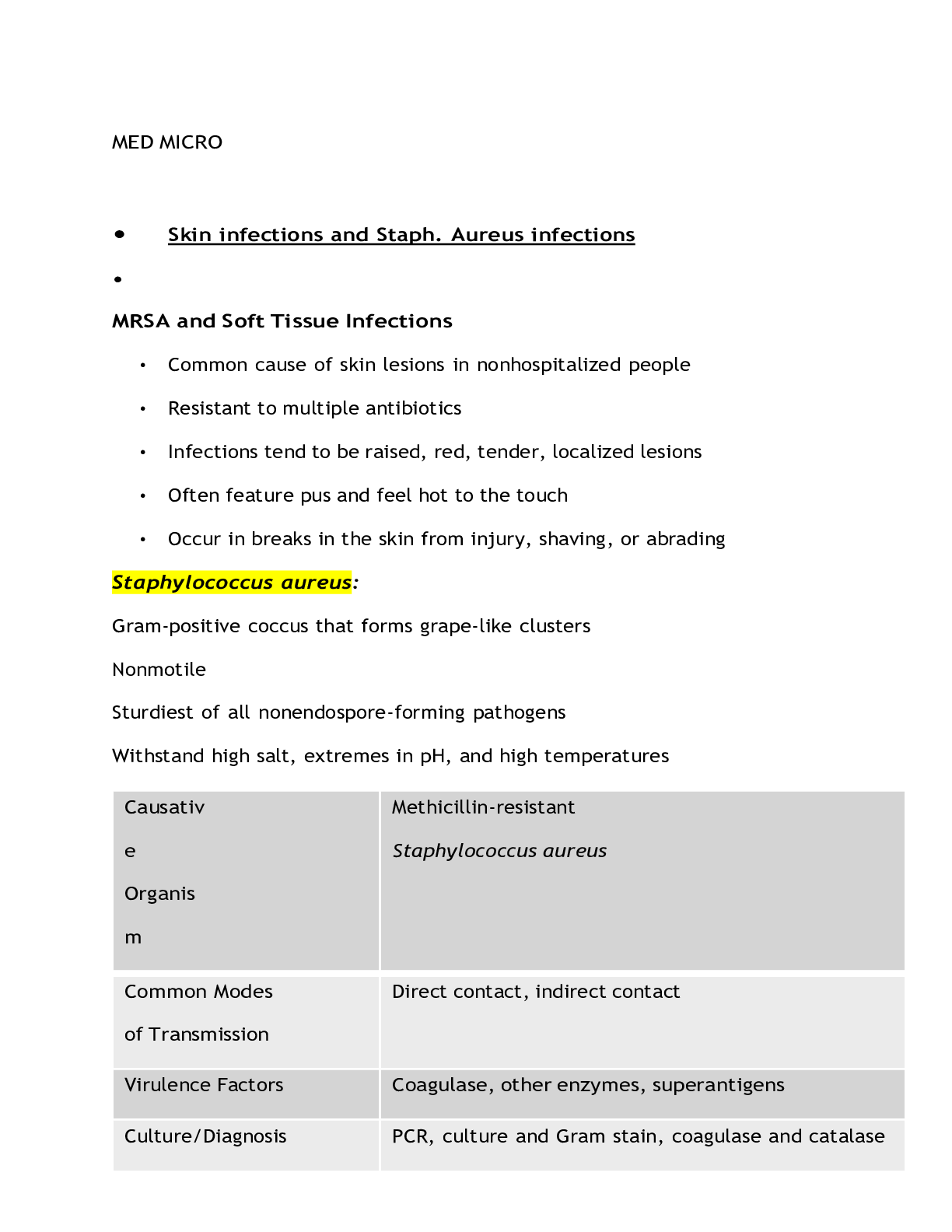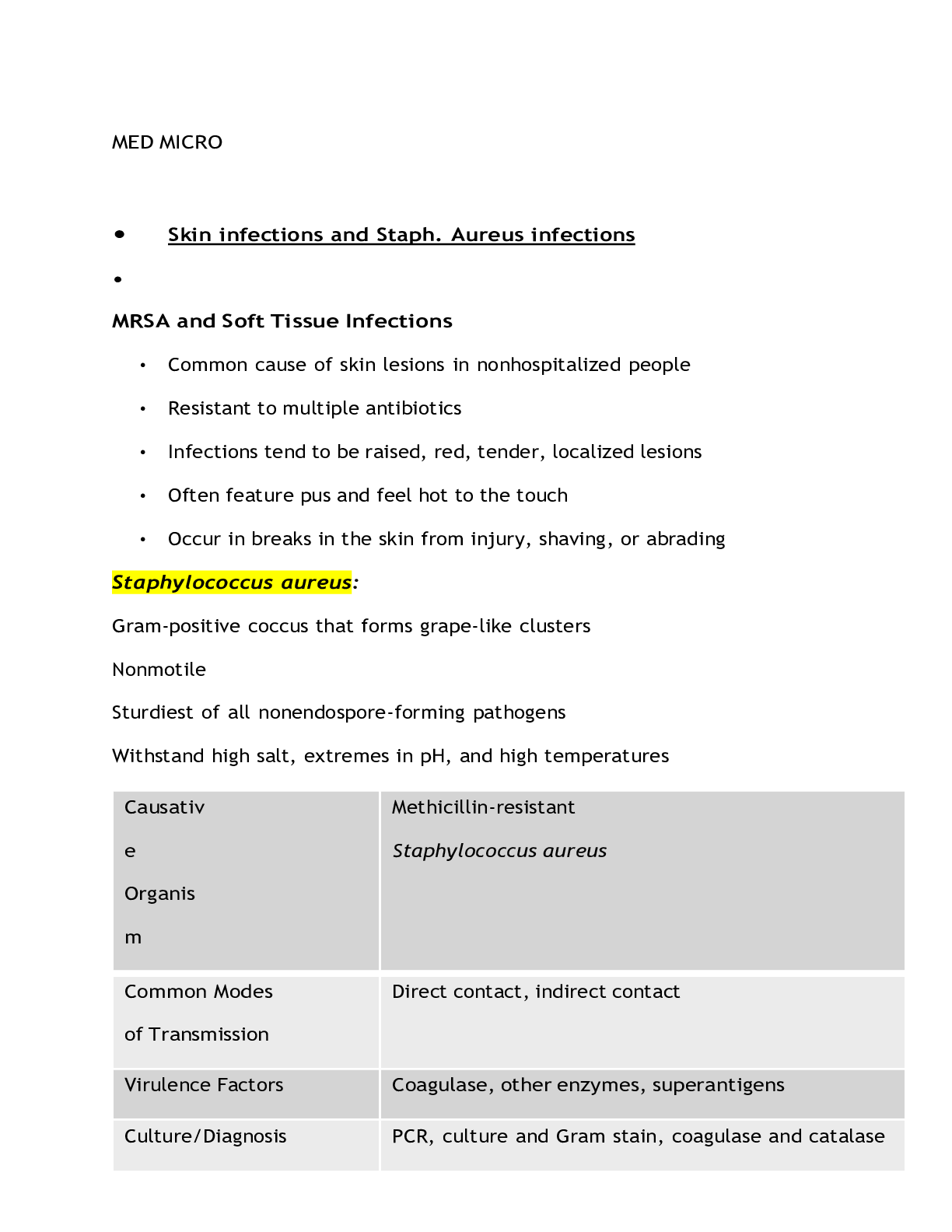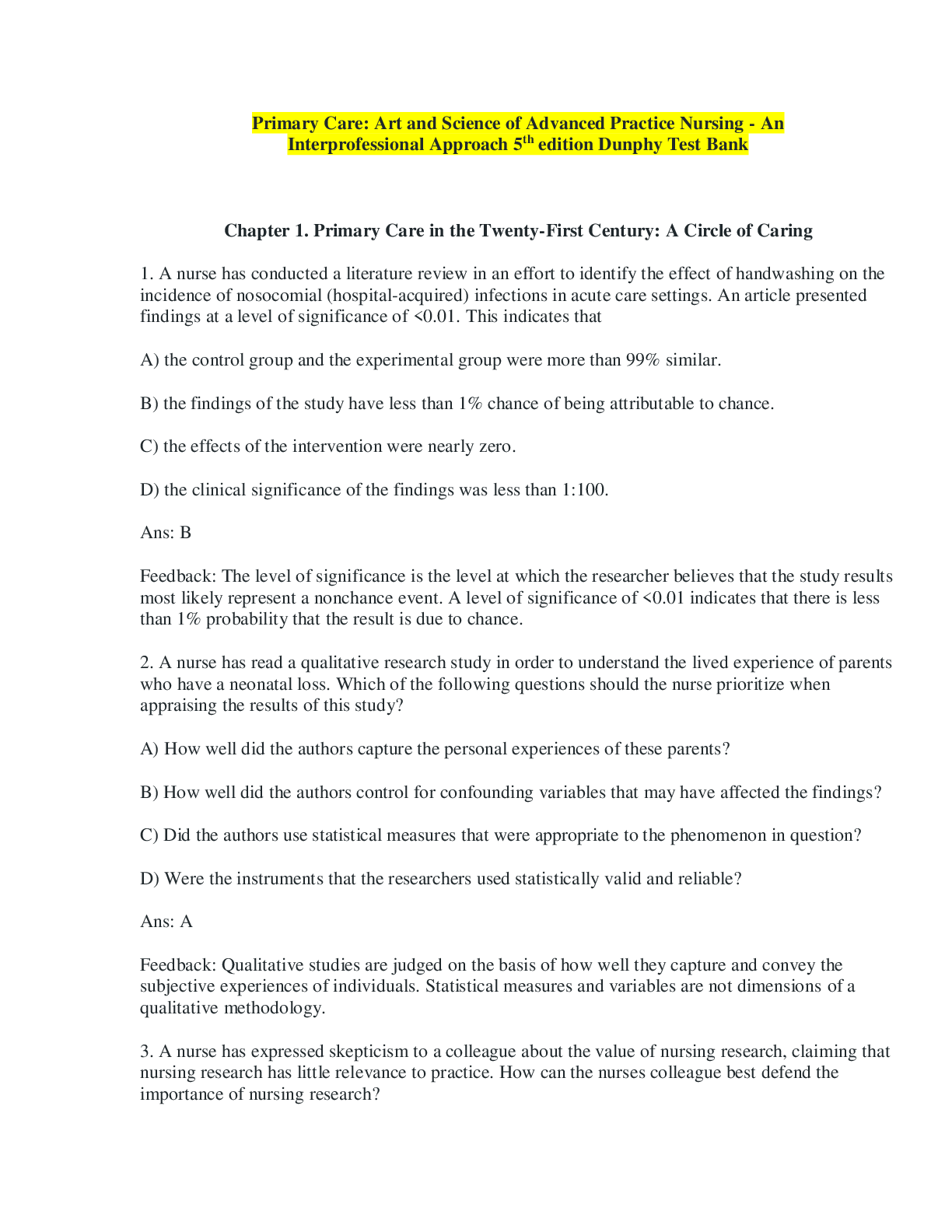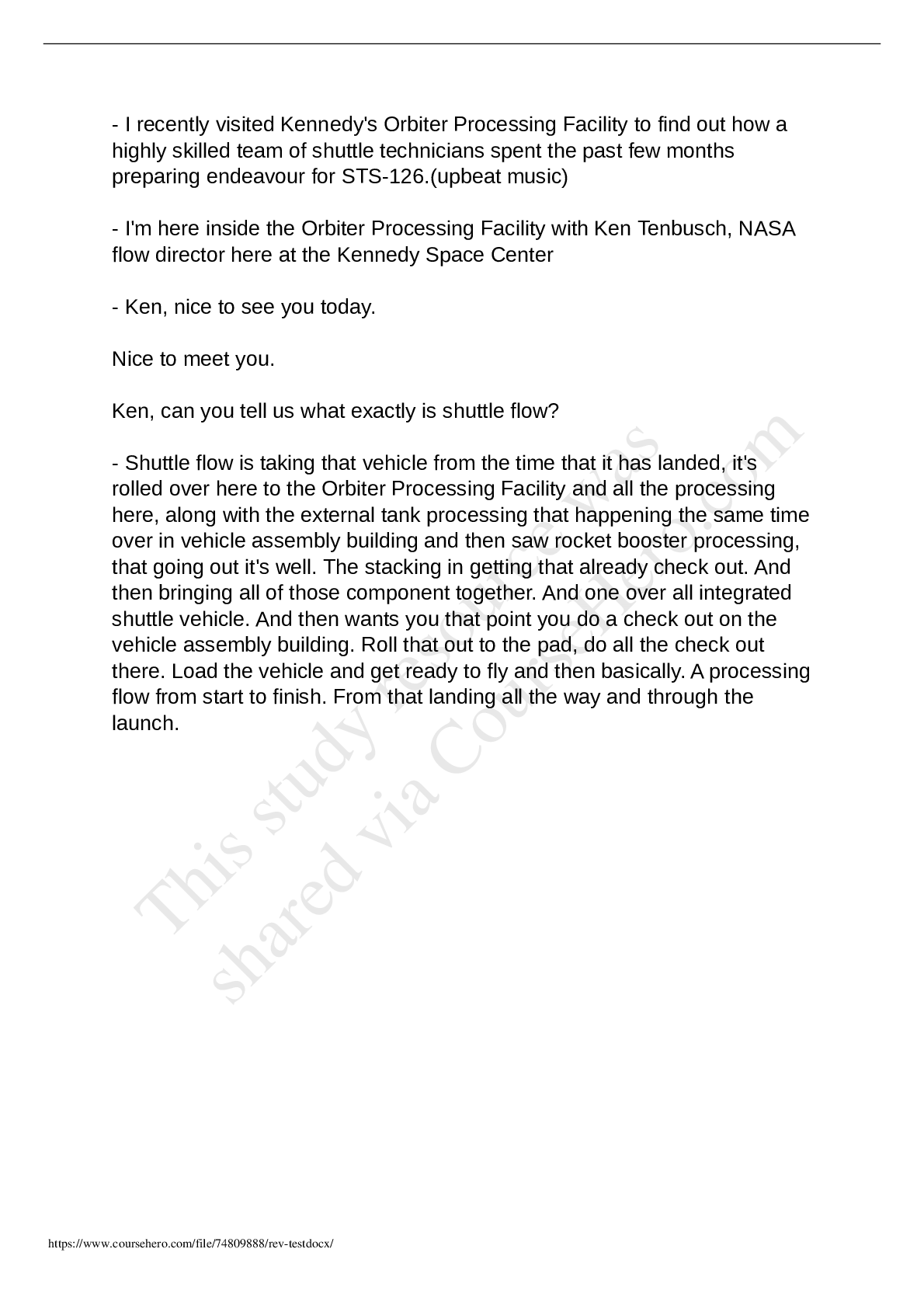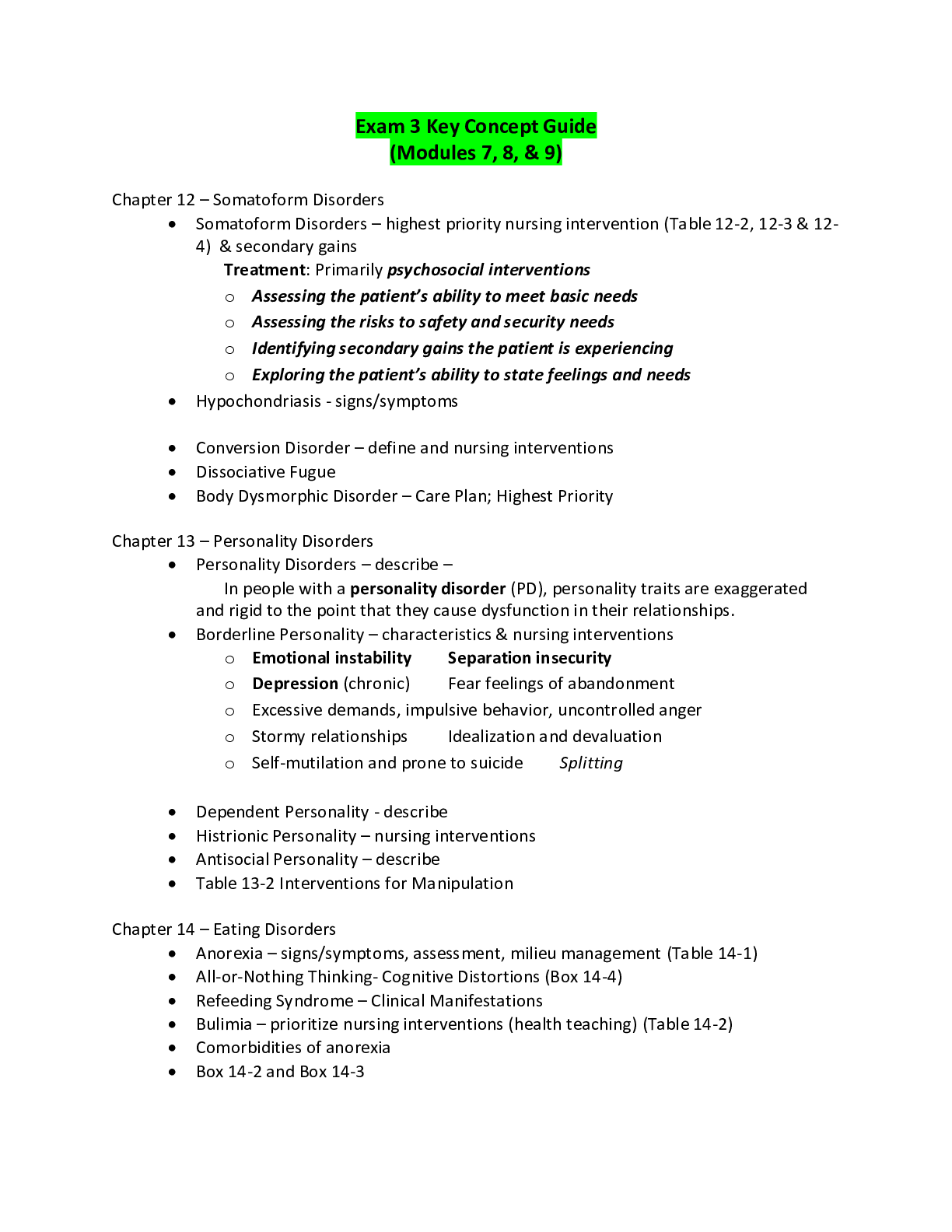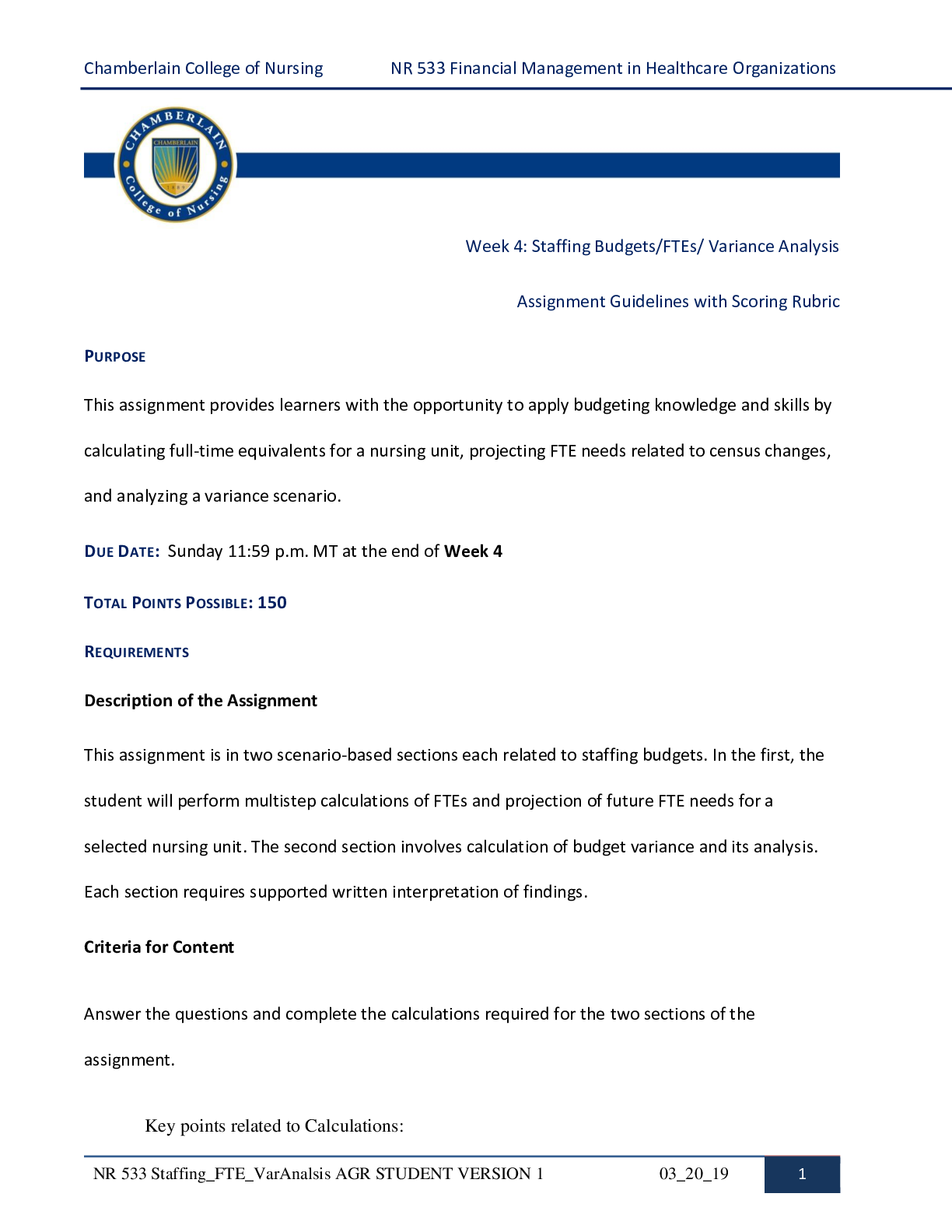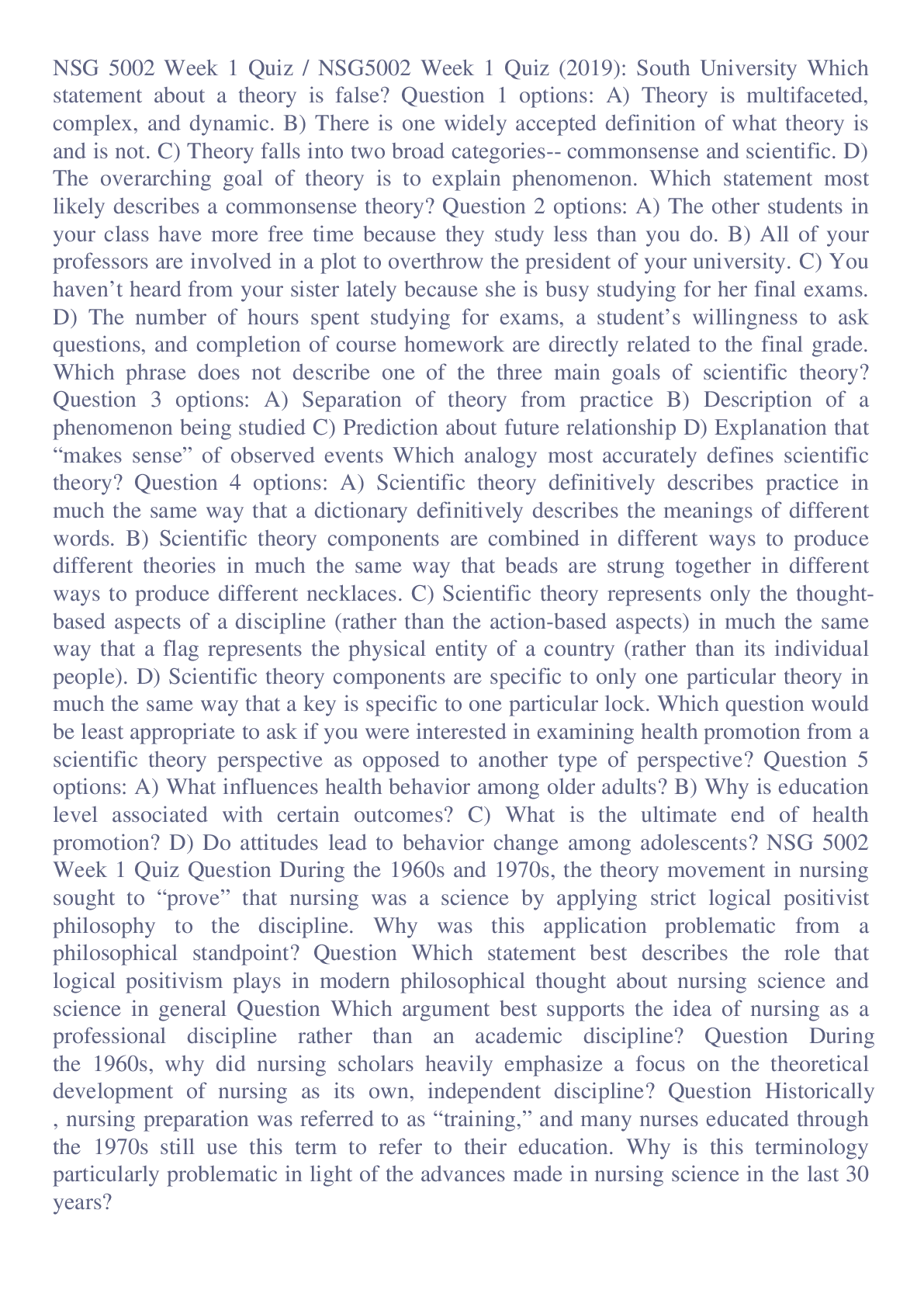*NURSING > STUDY GUIDE > Primary Care: Art and Science of Advanced Practice Nursing - An Interprofessional Approach 5th editi (All)
Primary Care: Art and Science of Advanced Practice Nursing - An Interprofessional Approach 5th edition Dunphy Test Bank
Document Content and Description Below
Primary Care: Art and Science of Advanced Practice Nursing - An Interprofessional Approach 5th edition Dunphy Test Bank Chapter 1. Primary Care in the Twenty-First Century: A Circle of Caring 1. A nur... se has conducted a literature review in an effort to identify the effect of handwashing onthe incidence of nosocomial (hospital-acquired) infections in acute care settings. An article presented findings at a level of significance of <0.01. This indicatesthat A) the control group and the experimental group were more than 99%similar. B) the findings of the study have less than 1% chance of being attributable tochance. C) the effects of the intervention were nearlyzero. D) the clinical significance of the findings was less than1:100. 2. A nurse has read a qualitative research study in order to understand the lived experience ofparents who have a neonatal loss. Which of the following questions should the nurse prioritize when appraising the results of thisstudy? A) How well did the authors capture the personal experiences of theseparents? B) How well did the authors control for confounding variables that may have affected thefindings? C) Did the authors use statistical measures that were appropriate to the phenomenon inquestion? D) Were the instruments that the researchers used statistically valid andreliable? 3. A nurse has expressed skepticism to a colleague about the value of nursing research, claimingthat nursing research has little relevance to practice. How can the nurses colleague best defend the importance of nursingresearch? A) The existence of nursing research means that nurses are now able to access federal grant money, something that didnt use to be thecase. B) Nursing research has allowed the development of masters and doctoral programs and hasgreatly increased the credibility of theprofession. C) The growth of nursing research has caused nursing to be viewed as a true profession, rather than simply as a trade or askill. D) The application of nursing research has the potential to improve nursing practice andpatient outcomes. 4. Tracy is a nurse with a baccalaureate degree who works in the labor and delivery unit of abusy urban hospital. She has noticed that many new mothers abandon breast-feeding their babies when they experience early challenges and wonders what could be done to encourage more women to continue breast-feeding. What role is Tracy most likely to play in a research project that tests an intervention aimed at promotingbreast-feeding? A) Applying for grant funding for the researchproject B) Posing the clinical problem to one or more nursingresearchers C) Planning the methodology of the researchproject D) Carrying out the intervention and submitting the results for publication . 5. A patient signed the informed consent form for a drug trial that was explained to patient by a research assistant. Later, the patient admitted to his nurse that he did not understand the research assistants explanation or his own role in the study. How should this patients nurse respond to this revelation? A) Explain the research process to the patient in greaterdetail. B) Describe the details of a randomized controlled trial for thepatient. C) Inform the research assistant that the patients consent is likelyinvalid. D) Explain to the patient that his written consent is now legallybinding. 6. A nurse leader is attempting to increase the awareness of evidence-based practice (EBP) among the nurses on a unit. A nurse who is implementing EBP integrates which of the following? (Select all thatapply.) A) Interdisciplinaryconsensus B) Nursingtradition C) Researchstudies D) Patient preferences andvalues E) Clinical expertise 7. Mrs. Mayes is a 73-year-old woman who has a diabetic foot ulcer that has been extremely slow to heal and which now poses a threat of osteomyelitis. The wound care nurse who has been working with Mrs. Mayes applies evidence-based practice (EBP) whenever possible and has proposed the use of maggot therapy to debride necrotic tissue. Mrs. Mayes, however, finds the suggestion repugnant and adamantly opposes this treatment despite the sizable body of evidence supporting it. How should the nurse reconcile Mrs. Mayes views with the principles ofEBP? A) The nurse should explain that reliable and valid research evidence overrides the patientsopinion. B) The nurse should explain the evidence to the patient in greaterdetail. C) The nurse should integrate the patients preferences into the plan ofcare. D) The nurse should involve the patients family members in the decision-makingprocess. 8. The administrators of a long-term care facility are considered the use of specialized, pressure- reducing mattresses in order to reduce the incidence of pressure ulcers among residents. They have sought input from the nurses on the unit, all of whom are aware of the need to implement the principles of evidence-based practice (EBP) in this decision. Which of the following evidence sources should the nursesprioritize? A) A qualitative study that explores the experience of living with a pressureulcer B) A case study that describes the measures that nurses on a geriatric unit took to reduce pressure ulcers amongpatients C) Testimonials from experienced clinicians about the effectiveness of the mattress inquestion D) A randomized controlled trial that compared the pressure-reducing mattress with standard mattresses 9. Hospital administrators are applying the principles of evidence-based practice (EBP) in their attempt to ascertain the most efficient and effective way to communicate between nurses who are on different units, a project that will consider many types of evidence. Which of the following information sources should the administratorsprioritize? A) A systematic review about communication in nursingcontexts B) Nurses ideas about communicationmethods C) The results of a chartreview D) The hospitals accreditation status . 10. A nurse has resolved to apply the evidence-based practice (EBP) process to the way that admission assessments are conducted and documented on a unit. How should the nurse begin the process of establishingEBP? A) Gather evidence showing the shortcomings of currentpractices B) Formulate a clear and concise question to beaddressed C) Elicit support from the nurses who are most often responsible foradmissions D) Search the literature for evidence that is potentially relevant to the practice need 11. Which of the following questions best exemplifies the PICOT format for asking evidence-based questions? A) What affect does parents alcohol use have on the alcohol use of their teenagechildren? B) Among postsurgical patients, what role does meditation rather than benzodiazepines haveon anxiety levels during the 48 hours followingsurgery? C) Among high school students, what is the effectiveness of a sexual health campaign undertaken during the first 4 weeks of the fall semester as measured by incidence of new sexually transmitted infections? D) In children aged 68, is the effectiveness of a descriptive pain scale superior to a numeric rating scale in the emergency roomcontext? 12. A nurse has made plans to implement the University of North Carolina (UNC) model of 5 As during the process of applying evidence-based practice (EBP) to a practice problem. What is the final step that the nurse will take in applying thismodel? A) Analyze the results of the EBPprocess B) Advocate for others to embrace the identifiedchange C) Adopt the changes identified in the reviewprocess D) Assess the outcomes of the new practice 13. A nurse has been asked to make a presentation to a group of high school students on the subject of sexual health. However, the nurse does not have a background in this practice area and requires rapid access to evidence-based guidelines. Which of the following strategies is most likely to provide the nurse with valid and reliable evidence in a time-efficientmanner? A) Search the Cochrane Library of SystematicReviews B) Google search terms such as sexual health teens and sexualeducation C) Search Medline using PubMed and order relevantarticles D) Scan the most recent issues of nursing journals that address this area ofpractice 14. The nurses at a university hospital have been informed that a computerized record system will be implemented over the next 12 months. The nurses should be aware that such as system presents particular challenges in the areaof A) vulnerability to errors in charting and the inability to makechanges. B) patient privacy and confidentiality ofrecords. C) enforcing compliance with the system on the part ofnurses. D) ensuring compatibility with different computer operatingsystems. 15. A nurse is nervous about the impeding introduction of computerized nursing care records atthe hospital because he does not consider himself to be technologically adept. How should this nurse best respond to thissituation? A) Take courses in advanced practice nursing to build hisknowledge. B) Explore employment opportunities in settings that use written documentationsystems. C) Advocate for a delay in the introduction of the proposedsystem. D) Seek out opportunities to learn the relevant knowledge and practice the necessaryskills. Chapter 2. Caring and the Advanced Practice Nurse Multiple Choice 1. A goal of community nursing is to provide primary prevention from disease. Which ofthe following nursing actions reflect thisgoal? A) A nurse creates a pamphlet discussing heart-healthy foods and distributes it in the neighborhood communitycenter. B) A nurse starts an intravenous line on a dehydrated baby who has been brought to theemergency department. C) A nurse performs range-of-motion exercises for a patient intraction. D) A nurse repositions an elderly patient confined to a wheelchair to avoid the formation of pressure ulcers. 2. A nurse decides to pursue a career in community-based nursing. Which of the following statements represents the environment in which the nurse will beworking? A) Community-based nursing is limited to work in public clinics, schools, andindustry. B) The key to community-based settings is that the nurse is incharge. C) The nurse serves as an educator, guide, and resource person and determines the action takenby the client. D) Care in the community iscost-effective. 3. The movement of a client from acute care to a long-term nursing care facility involves planningto provide continuity of care. What is the term for this type ofplanning? A) Dischargeplanning B) Comprehensiveplanning C) Ongoing planning D) Transition planning 4. A nurse is called into work to perform triage in the aftermath of an earthquake. Which of the following are the expected responsibilities of thisnurse? A) Set up and monitor IVlines. B) Prepare the emergency room for multiplevictims. C) Screen victims to prioritizetreatment. D) Check available blood products and assist withtransfusions. 5. A client asks a nurse for help in obtaining an alternative healthcare provider. Which of the following is an accurate fact regarding alternative care that the nurse should share with thisclient? A) Most alternative healthcare practitioners do not have education-based credentials to practice their medicine. B) Alternative providers are not usually included in the federal HIPAA legislation that mandates confidentiality in conventional healthcaresettings. C) The cost of alternative therapy is never covered by insurance carriers or healthcareplans. D) It is easy to find accurate safety and efficacy data for alternative medicine on theInternet. 6. There is an increasing trend for nursing care to move from the hospital setting into the community. Nurses who are to provide excellent care in a community setting should prioritize which of thefollowing? A) Integrating culture and family into the planning and delivery ofcare B) Becoming more assertive in client education and the planning of clientcare C) Encouraging clients to limit their interactions withphysicians D) Teaching clients to replace biomedical interventions with complementary therapies 7. In spite of the important role that hospitals play in American healthcare, there is growing importance of community-based healthcare and community-based nursing. Which of the following statements best conveys a central aspect of the philosophy of communitycare? A) The client is in charge of his or her health and healthcare in thecommunity. B) Nurses maximize their scope of practice in noninstitutionalsettings. C) Community settings allow for the greatest number and variety of treatmentoptions. D) The nurse becomes the key member of the healthcare team in a communitysetting. 8. Mr. Hammond is a 70-year-old man with a diagnosis of type 1 diabetes who developed a diabetic foot ulcer earlier this year. He has recently been discharged from the hospital and now requires regular wound care. Karen is a community health nurse who provides wound care for Mr.Hammond twice weekly. Which of Karens actions is most likely to empower Mr.Hammond? A) Encourage Mr. Hammond to acknowledge his contribution to the development of hiswound. B) Provide information to Mr. Hammond that matches his expressedneeds. C) Encourage Mr. Hammond to involve members of his family in hiscare. D) Delegate wound care to Mr. Hammond and reduce the frequency of hervisits. 9. An elderly female client who resides in the community tends to defer decisions regarding her care to her eldest son. How should the community health nurse respond to the clients reluctance to make independentdecisions? A) Discuss this observation with the client and her son in an open manner and explorealternatives. B) Organize care so that it takes place at times when the son is not present in thehome. C) Accommodate this aspect of the clients family dynamics when planning and carrying outcare. D) Teach the client assertiveness skills that she can apply in her interactions with herson. 10. A client with a long-standing diagnosis of chronic obstructive pulmonary disease (COPD) has been enrolled in a disease management program. Which of the following activities will beprioritized in thisprogram? A) Providing comprehensive and evidence-based care of the clientsCOPD B) Creating collaborative relationships between the client and the careteam C) Ensuring that the client qualifies for Medicare andMedicaid D) Liaising between the client and his health maintenance organization (HMO) 11. One of the expressed goals of Healthy People 2020 is to achieve health equity and eliminate disparities. What health indicator can most accurately gauge whether this goal is beingachieved? A) Environmentalquality B) Injury andviolence C) Mentalhealth D) Access to healthcareservices 12. Nurses have the potential to positively impact the health of communities. Which of thefollowing actions is most likely to improve the health of acommunity? A) Publicizing the consequences of unhealthylifestyles B) Advocating politically for laws and policies that foster communityhealth C) Ensuring that nurses are practicing to the full extent of their scope ofpractice D) Providing nursing care to individuals who are not patients or clients 13. A nurse who provides care in an acute medical unit is aware of the importance of thorough discharge planning. The discharge planning process shouldbegin A) once the patient has stabilized and is assured of positiveoutcomes. B) as soon as possible after the patient isadmitted. C) once the patient has received a discharge order from his or her primary careprovider. D) 48 to 72 hours before the projected date ofdischarge. 14. A hospital patient has discussed with the nurse her use of visualization, biofeedback, and relaxation exercises in managing the chronic pain that results from her fibromyalgia. The nurse should recognize this patients use of what category of complementary/alternative medicine(CAM)? A) Biologically-basedpractices B) Manipulativepractices C) Traditional indigenousmedicine D) Mind-body 15. A hospital patient who suffered a spinal cord injury has expressed an interest in exploring complementary/alternative therapies. The nurse should encourage the patient to begin this processby doing which of the followingactivities? A) Asking practitioners of different therapies to provide lists of satisfiedclients B) Asking the patients primary care provider for permission to explore nonbiomedicaltreatments C) Finding reliable evidence regarding the safety and effectiveness oftherapies D) Determining whether the patients health insurance would cover the cost of alternative/complementarytherapies Chapter 3. Health Promotion Multiple Choice Identify the choice that best completes the statement or answers the question. 1. Which of the following is a primary prevention measure for a 76-year-old man newly diagnosed with a testosteronedeficiency? a. Calciumsupplementation b. Testicularself-examination c. Bone densitytest d. Digital rectalexamination 2. Which of the following is an example of secondary prevention in a 50-year-oldwoman? a. Yearlymammogram b. Low animal fatdiet c. Use of seatbelt d. Daily application ofsunscreen 3. Which of the following is an example of tertiary prevention in a patient with chronic renalfailure? a. Fluidrestriction b. Hemodialysis 4 days aweek c. High-proteindiet d. Maintenance of blood pressure at120/80 4. Immunizations are an example of which type ofprevention? a. Primary b. Secondary c. Tertiary True/False Indicate whether the statement is true or false. 1. Prevalence is the number of new cases of a particulardisease. 2. The number of cases of a particular disease for the past 5 years is an example of the incidencerate. 3. “There are 1,185,000 cases of HIV/AIDS in the United States” is an example of the morbidityrate. 4. Endemic is the term used when the presence of an event isconstant. 5. The “bird” flu of 2005 to 2006 is considered a sporadicoutbreak. 6. A pandemic affects many communities in a short period oftime. Chapter 4. The Art of Diagnosis and Treatment MULTIPLE CHOICE 1. An 85-year-old man has come in for a physical examination, and the nurse notices that he uses a cane. When documenting general appearance, the nurse should document this information under the section thatcovers: a. Posture. b. Mobility. c. Mood andaffect. d. Physicaldeformity. . 2. The nurse is performing a vision examination. Which of these charts is most widely usedfor visionexaminations? a. Snellen b. Shetllen c. Smoollen d. Schwellon 3. After the health history has been obtained and before beginning the physical examination,the nurse should first ask the patientto: a. Empty thebladder. b. Completelydisrobe. c. Lie on the examinationtable. d. Walk around theroom. 4. During a complete health assessment, how would the nurse test the patientshearing? a. Observing how the patient participates in normalconversation b. Using the whispered voicetest c. Using the Weber and Rinnetests d. Testing with anaudiometer 5. A patient states, Whenever I open my mouth real wide, I feel this popping sensation in front ofmy ears. To further examine this, the nursewould: a. Place the stethoscope over the temporomandibular joint, and listen forbruits. b. Place the hands over his ears, and ask him to open his mouth reallywide. c. Place one hand on his forehead and the other on his jaw, and ask him to try to open hismouth. d. Place a finger on his temporomandibular joint, and ask him to open and close his mouth. 6. The nurse has just completed an examination of a patients extraocular muscles. When documenting the findings, the nurse should document the assessment of which cranialnerves? a. II, III, andVI b. II, IV, andV c. III, IV, andV d. III, IV, andVI 7. A patients uvula raises midline when she says ahh, and she has a positive gag reflex. The nurse has just tested which cranialnerves? a. IX andX b. IX andXII c. X andXII d. XI andXII 8. During an examination, the nurse notices that a patient is unable to stick out his tongue.Which cranial nerve is involved with the successful performance of thisaction? a. I b. V c. XI d. XII . 9. A patient is unable to shrug her shoulders against the nurses resistant hands. What cranial nerve is involved with successful shouldershrugging? a. VII b. IX c. XI d. XII . 10. During an examination, a patient has just successfully completed the finger-to-nose and the rapid-alternating-movements tests and is able to run each heel down the opposite shin. The nurse will conclude thatthepatients function is intact. a. Occipital b. Cerebral c. Temporal d. Cerebellar . 11. When the nurse performs the confrontation test, the nurse hasassessed: a. Extraocular eye muscles(EOMs). b. Pupils (pupils equal, round, reactive to light, and accommodation[PERRLA]). c. Near vision. d. Visualfields. 12. Which statement is true regarding the complete physicalassessment? a. The male genitalia should be examined in the supineposition. b. The patient should be in the sitting position for examination of the head andneck. c. The vital signs, height, and weight should be obtained at the end of the examination. d. To promote consistency between patients, the examiner should not vary the order of theassessment. 13. Which of these is included in an assessment of generalappearance? a. Height b. Weight c. Skin color d. Vital signs 14. The nurse should wear gloves for which of theseexaminations? a. Measuring vitalsigns b. Palpation of thesinuses c. Palpation of the mouth andtongue d. Inspection of the eye with anophthalmoscope 15. The nurse should use which location for eliciting deep tendonreflexes? a. Achilles b. Femoral c. Scapular d. Abdominal 16. During an inspection of a patients face, the nurse notices that the facial features aresymmetric. This finding indicates which cranial nerve isintact? a. VII b. IX c. XI d. XII 17. During inspection of the posterior chest, the nurse should assessfor: a. Symmetricexpansion. b. Symmetry of shoulders andmuscles. c. Tactilefremitus. d. Diaphragmaticexcursion. 18. During an examination, the patient tells the nurse that she sometimes feels as if objects are spinning around her. The nurse would document that she occasionallyexperiences: a. Vertigo. b. Tinnitus. c. Syncope. d. Dizziness. 19. A patient tells the nurse, Sometimes I wake up at night and I have real trouble breathing. Ihave to sit up in bed to get a good breath. When documenting this information, the nurse wouldnote: a. Orthopnea. b. Acuteemphysema. c. Paroxysmal nocturnaldyspnea. d. Acute shortness of breathepisode. 20. During the examination of a patient, the nurse notices that the patient has several small, flat macules on the posterior portion of her thorax. These macules are less than 1 cm wide.Another name for these macules is: a. Warts. b. Bullae. c. Freckles. d. Papules. 21. During an examination, the nurse notices that a patients legs turn white when they are raised above the patients head. The nurse shouldsuspect: a. Lymphedema. b. Raynauddisease. c. Chronic arterialinsufficiency. d. Chronic venousinsufficiency. 22. The nurse documents that a patient has coarse, thickened skin and brown discoloration overthe lower legs. Pulses are present. This finding is probably the resultof: a. Lymphedema. b. Raynauddisease. c. Chronic arterialinsufficiency. d. Chronic venousinsufficiency. 23. The nurse notices that a patient has ulcerations on the tips of the toes and on the lateral aspectof the ankles. This findingindicates: a. Lymphedema. b. Raynauddisease. c. Arterialinsufficiency. d. Venousinsufficiency. 24. The nurse has just recorded a positive iliopsoas test on a patient who has abdominal pain. This test is used to confirma(n): a. Inflamedliver. b. Perforatedspleen. c. Perforatedappendix. d. Enlargedgallbladder. . 25. The nurse will measure a patients near vision with whichtool? a. Snellen eye chart withletters b. Snellen Echart c. Jaegercard d. Ophthalmoscope 26. If the nurse records the results to the Hirschberg test, the nursehas: a. Tested the patellarreflex. b. Assessed forappendicitis. c. Tested the corneal lightreflex. d. Assessed forthrombophlebitis. 27. During the examination of a patients mouth, the nurse observes a nodular bony ridge down the middle of the hard palate. The nurse would chart this findingas: a. Cheilosis. b. Leukoplakia. c. Ankyloglossia. d. Toruspalatinus. 28. During examination, the nurse finds that a patient is unable to distinguish objects placed in his hand. The nurse woulddocument: a. Stereognosis. b. Astereognosis. c. Graphesthesia. d. Agraphesthesia. 29. After the examination of an infant, the nurse documents opisthotonos. The nurse recognizesthat this finding often occurswith: a. Cerebralpalsy. b. Meningealirritation. c. Lower motor neuronlesion. d. Upper motor neuronlesion. 30. After assessing a female patient, the nurse notices flesh-colored, soft, pointed, moist, papules in a cauliflower-like patch around her introitus. This finding is mostlikely: a. Urethralcaruncle. b. Syphiliticchancre. c. Herpes simplexvirus. d. Humanpapillomavirus. 31. While recording in a patients medical record, the nurse notices that a patients Hematest results are positive. This finding means that thereis(are): a. Crystals in hisurine. b. Parasites in hisstool. c. Occult blood in hisstool. d. Bacteria in hissputum. 32. While examining a 48-year-old patients eyes, the nurse notices that he had to move thehandheld vision screener farther away from his face. The nurse wouldsuspect: a. Myopia. b. Omniopia. c. Hyperopia. d. Presbyopia. Chapter 5. Evidence-Based Care Multiple Choice Identify the choice that best completes the statement or answers the question. 1. Which of the following are parts of evidence-basedpractice? a. Clinician b. Patient c. Evidence d. All of theabove 2. Which is the most important question to ask in nursingresearch? a. What findings constituteevidence? b. How will the findings beused? c. Is this a randomized controlledtrial? d. What theory is beingutilized? 3. Nursing research should be utilizedby: a. Nurses at thebedside b. Advanced practicenurses c. Nurseresearchers d. Nurses at all levels ofpractice 4. Applying evidence at the point of carerequires: a. Readily available evidence-basedresources b. Ability to review researchliterature c. Single articles injournals d. Currenttextbooks 5. Practice guidelines are designedto: a. Beinflexible b. Be utilized in everycircumstance c. Provide a reference point for decision making d. Be created by a professional organization to guide the practice of aprofession 6. Which of the following is a crucial element of developing aguideline? a. Creating a physician expertpanel b. Reviewing the literature with ratings of availableevidence c. Conducting an external review of aguideline d. Developing evidence-basedtables 7. Which of the following would be considered the research design for Level Ievidence? a. Single, well-designed randomized clinicaltrial b. Systematic review of randomized clinical trialstudies c. Well-designed controlled trials withoutrandomization d. Systematic reviews of descriptive or qualitativestudies 8. Which of the following would be considered the research design for Level IIevidence? a. Single descriptive or qualitativestudy b. Well-designed case control or cohortstudies c. Single, well-designed, randomized clinicaltrial d. Systematic review of randomized clinical trialstudies 9. Which of the following would be considered the research design for Level IIIevidence? a. Well-designed controlled trials withoutrandomization b. Systematic reviews of descriptive or qualitativestudies c. Systematic review of randomized clinical trialstudies d. Opinion of authorities and expertcommittees 10. Which of the following would be considered the research design for Level IVevidence? a. Single descriptive or qualitativestudy b. Opinion of authorities and expertcommittees c. Systematic review of randomized clinical trialstudies d. Well-designed controlled trials withoutrandomization 11. Which of the following would be considered the research design for Level Vevidence? a. Systematic review of randomized clinical trialstudies b. Well-designed controlled trials withoutrandomization c. Systematic reviews of descriptive or qualitativestudies d. Single descriptive or qualitativestudy 12. Which of the following would be considered the research design for Level VIevidence? a. Systematic reviews of descriptive or qualitativestudies b. Opinion of authorities and expertcommittees c. Well-designed case control or cohortstudies d. Single descriptive or qualitativestudy 13. Which of the following would be considered the research design for Level VIIevidence? a. Well-designed controlled trials withoutrandomization b. Opinion of authorities and expertcommittees c. Well-designed case control or cohortstudies d. Single descriptive or qualitativestudy Chapter 6. Common Neurological Complaints Multiple Choice Identify the choice that best completes the statement or answers the question. 1. Which statement about confusion istrue? a. Confusion is a diseaseprocess. b. Confusion is alwaystemporary. c. Age is a reliable predictor ofconfusion. d. Polypharmacy is a major contributor to confusion in olderadults. 2. Sondra’s peripheral vestibular disease causes dizziness and vertigo. Which of the following medications will help to decrease edema in the labyrinth of theear? a. Meclizine b. Diphenhydramine c. Diamox d. Promethazine 3. The hallmark of an absence seizureis: a. No activity atall b. A blankstare c. Urine is usually voidedinvoluntarily d. The attack usually lasts severalminutes 4. How often should drug levels be monitored when a seizure medication has controlled the seizures, and the drug level isadequate? a. Every 3months b. Every 6months c. Annually d. Whenever there is aproblem 5. Which of the following persons fits the classic description of a patient with multiple sclerosis(MS)? a. A teenagemale b. A 65-year-oldmale c. A 25-year-oldfemale d. A 60-year-oldfemale 6. Which of the following is a specific test toMS? a. Magnetic resonance imaging(MRI) b. Computed tomography (CT)scan c. A lumbarpuncture d. There is no specifictest. 7. Which drug for Alzheimer’s disease should be administered beginning at the time ofdiagnosis? a. Cholinesteraseinhibitors b. Anxiolytics c. Antidepressants d. Atypicalantipsychotics 8. Which hematoma occurs along the temporal cranial wall and results from tears in the middle meningealartery? a. Epiduralhematoma b. Subduralhematoma c. Subarachnoidhematoma d. Intraparenchymalhemorrhage 9. Which cranial nerve is affected in a patient with a cerebrovascular accident who has difficulty chewing? a. CNV b. CNVII c. CNIX d. CNX 10. Which statement best describes a carotidbruit? a. It is felt with the middle three fingers over the carotidartery. b. A bruit becomes audible when the lumen is narrowed to 1 mm orless. c. A low-pitched bruit is a medicalemergency. d. The higher the pitch of the bruit, the higher the degree ofstenosis. 11. Which patient is more likely to have a clusterheadache? a. A female in her reproductiveyears b. A 40-year-old African Americanmale c. A 55-year-old female who drinks 10 cups of coffeedaily d. A 45-year-old male awakened atnight 12. Inattention and a sleep-wake cycle disturbance are the hallmark symptomsof? a. Dementia b. Alzheimer’sdisease c. Parkinson’sdisease d. Delirium 13. Which type of meningitis is more benign, self-limiting, and caused primarily by avirus? a. Purulentmeningitis b. Chronicmeningitis c. Asepticmeningitis d. Herpesmeningitis 14. Which is the most sensitive neuroimaging test to evaluate patients withencephalitis? a. MRI b. CT c. Electroencephalogram(EEG) d. An initial lumbarpuncture 15. What is usually the first sign or symptom that a patient would present with that would make you suspect herpeszoster? a. A stabbing pain on one small area of thebody b. A vesicular skin lesion on one side of thebody c. A pain that is worse uponawakening d. A lesion on the exterior earcanal 16. Gabby, aged 22, has Bell’s palsy on the right side of her face. Her mouth is distorted, and she is concerned about permanent paralysis and pain. What do you tellher? a. “Most patients have complete recovery in 3 to 6months.” b. “Unfortunately, you’ll probably have a small amount of residualdamage.” c. “Don’t worry, I’ll take care ofeverything.” d. “You may have a few more episodes over the course of your lifetime but no permanentdamage.” 17. Sam, aged 65, is started on L-dopa for his Parkinson’s disease (PD). He asks why this isnecessary. You tell him: a. “L-dopa isneuroprotective.” b. “The primary goal of therapy is to replace depleted stores ofdopamine.” c. “This is the only drug that can provide symptomaticbenefit.” d. “This is the initial monotherapydrug.” 18. Which of the following signs is seen in a patient with more advancedPD? a. Restingtremor b. Bradykinesia c. Rigidity d. Posturalinstability 19. Which of the following is the most commonly experienced symptom ofmigraine? a. Lightsensitivity b. Pulsatilepain c. Soundsensitivity d. Experiencing anaura 20. Which of the following characteristics differentiates peripheral vertigo from centralvertigo? a. The duration of central vertigo is shorter than that of peripheralvertigo. b. There is an auditory-associated symptom with peripheral vertigo and a visual- associated symptom with centralvertigo. c. Central vertigo is positional, and peripheral vertigo isnot. d. The onset of central vertigo is more sudden than that of peripheralvertigo. 21. Carotid endarterectomy should be considered only for symptomatic patients with greater than what percentage ofstenosis? a. Greater than25% b. Greater than50% c. Greater than75% d. Only for 100%occlusion 22. What antiplatelet agent is most widely used for secondary prevention ofstroke? a. Aspirin b. Ticlopidine c. Clopidogrel d. Aspirin andclopidogrel 23. Which adjunctive diagnostic test should be used in the work-up of a patient with suspected Creutzfeldt-Jakob disease or transient epilepticamnesia? a. MRI b. CT c. Cerebrospinal fluidanalysis d. EEG 24. Which herbal preparation may cause delirium and should be avoided in an elderlypatient? a. Sam-e b. Saint John’sWort c. Melatonin d. SawPalmetto 25. Which of the following activities is part of the functional activitiesquestionnaire? a. Asking the patient to unravel a Rubik’scube b. Determining if the patient can drive on thehighway c. Asking the patient about a news event from the currentweek d. Seeing if the patient can keep his or her homeclean 26. About 90% of all headachesare? a. Tension b. Migraine c. Cluster d. Without pathologicalcause 27. Which statement is true regarding driving and patients with a seizuredisorder? a. Once diagnosed with a seizure disorder, patients must never driveagain. b. After being seizure free for 6 months, patients maydrive. c. Each state has different laws governing driving for individuals with a seizure disorder. d. These persons may drive but neveralone. 28. Julie has relapsing-remitting muscular sclerosis. She has not had a good response tointerferon. Which medication might help given intravenously once a month? a. Glatirameracetate b. Natalizumab c. Fingolimod d. Glucocorticoids 29. The ‘freezing phenomenon’ is a cardinal featureof? a. Parkinson’sdisease b. Alzheimer’sdisease c. ACVA d. Bell’spalsy 30. A ratchet-like rhythmic contraction, especially in the hand, during passive stretching is knownas? a. Spinothalamicdysfunction b. Ratcheting c. Cogwheeling d. Handtremors 31. Clinical features of insidious onset, slow progression, and a lack of other findings to explain the symptoms are fairly diagnostic of whichcondition? a. Guillain-Barrésyndrome b. Parkinson’sdisease c. Alzheimer’sdisease d. Huntington’sdisease 32. Which condition is characterized by the impaired ability to learn new information along with either a cognitive disturbance in language, function, orperception? a. Guillain-Barrésyndrome b. Parkinson’sdisease c. Alzheimer’sdisease d. Delirium 33. A score of 20 to 25 on this test indicates early-stage Alzheimer’sdisease: a. SLUMS b. MoCA c. FAST d. MMSE 34. Intravenous thrombolytic therapy following an ischemic CVA should be given within how many hours of symptomonset? a. 1 hour b. 3 hours c. 6 hours d. 12 hours 35. When administered at the beginning of an attack, oxygen therapy may help this kind ofheadache? a. Tension b. Migraine c. Cluster Chapter 7. Seizure Disorders 1. A client asks the nurse to explain symptoms that would indicate the presence of a brain tumor. Which ofthe following should the nurse respond to this client? (Select all thatapply.) 1. There are no symptoms specific to a braintumor. 2. Dizziness is a commonsymptom. 3. Ringing or buzzing in the ears canoccur. 4. Seizures mayoccur. 5. A headache that gets worse in the afternoon is specific to a braintumor.. 6. A headache is usually experienced by 50% of all people diagnosed with a braintumor. 2. The nurse is instructing a client diagnosed with a brain tumor on symptoms to immediately report toher physician. Which of the following should be included in these instructions? (Select all thatapply.) 1. New onset ofseizures 2. One-sidedweakness 3. Loss ofbalance 4. Problems withvision 5. Inability totalk 6. Loss ofappetite 3.A client is diagnosed with seizures occurring because of hepatic encephalopathy. The nurse realizes that the cause for this clients seizures wouldbe: 1. physiological. 2. iatrogenic. 3. idiopathic. 4. psychokinetic. 4.A client tells the nurse that he sees flashing lights that occur prior to the onset of a seizure. Which of the following phases of a seizure is this client describing to thenurse? 1. Prodromalphase 2. Aural phase 3. Ictalphase 4. Postictalphase 5.A client is experiencing a grand mal seizure. Which of the following should the nurse do during this seizure? 2. Leave the clientalone. 3. Give water to the client to avoiddehydration. 4. Place a finger in the clients mouth to avoid swallowing thetongue. 6.A client is prescribed phenytoin (Dilantin) for a seizure disorder. Which of the following would indicate that the client is adhering to the medicationschedule? 1. The client issleepy. 2. The client is not experiencingseizures. 3. The client no longer hasheadaches. 4. The client is eating morefood. 7. The nurse is unable to insert an intravenous access line into a client who is currentlyexperiencing a seizure. Which of the following routes can the nurse use to provide medication to the client at this time? 1. Oral 2. Intranasal 4. Intramuscular 8. One of the most important things a nurse can teach a client about seizure control isto: 1. take the medication every day as prescribed by thedoctor. 2. eat a balanceddiet. 3. get lots ofexercise. 4. take naps during theday. 9.A client is diagnosed with tonic-clonic seizures. Which are the characteristics of these types of seizures? (Select all thatapply.) 1. Progressing through all of the seizurephases 2. Beginning before age5 3. Lasting 2 to 3minutes 4. Causing injury to theclient 5. Occurring at any time, day ornight Chapter 8. Degenerative Disorders MULTIPLE CHOICE 1.A client is diagnosed with a headache from a secondary cause. The nurse realizes this type of headache can be caused by: 1.a tumor. on. 3.a migraine. er 2.The nurse should instruct a client diagnosed with migraine headaches to be careful not to overdose on acetaminophen (Tylenol). Which drug should the nurse tell the patient to avoid? 1.Aleve 2.Aspirin 3.Ibuprofen 4.Vicodin 3.A client is diagnosed with seizures occurring because of hepatic encephalopathy. The nurse realizes that the cause for this clients seizures would be: ological. genic. athic. okinetic. 4.A client tells the nurse that he sees flashing lights that occur prior to the onset of a seizure. Which of the following phases of a seizure is this client describing to the nurse? 1.Prodromal phase 2.Aural phase 3.Ictal phase 4.Postictal phase 5.A client is experiencing a grand mal seizure. Which of the following should the nurse do during this seizure? 1.Protect the clients head. 2.Leave the client alone. 3. Give water to the client to avoiddehydration. 4. Place a finger in the clients mouth to avoid swallowing thetongue. 6.A client is prescribed phenytoin (Dilantin) for a seizure disorder. Which of the following would indicate that the client is adhering to the medication schedule? 1. The client issleepy. 2. The client is not experiencing seizures. 3.The client no longer hasheadaches. 4.The client is eating more food. 7.The nurse is unable to insert an intravenous access line into a client who is currently experiencing a seizure. Which of the following routes can the nurse use to provide medication to the client at this time? 1.Oral 2.Intranasal 3.Rectal 4.Intramuscular 8.One of the most important things a nurse can teach a client about seizure control is to: the medication every day as prescribed by the doctor. a balanced diet. lots of exercise. naps during the day. 9.The nurse is instructing a client newly diagnosed with multiple sclerosis (MS). To determine the effectiveness of his teaching, the nurse would expect the client to state: 1.It is best for me to be in a cold environment. 2.I should avoid taking a hot bath. 3.I should eat foods low in salt. 4.I should be better in a week. . 10.An adult female in her 30s complains of numbness and tingling in the hands, fatigue, loss of coordination, incontinence, nystagmus, and ataxia. Which of the following health problems do these symptoms suggest to the nurse? 1.Brain tumor 2.Myasthenia gravis 3.Multiple sclerosis 4.Diabetes 11.For a client diagnosed with Parkinsons disease, which of the following might be contraindicated? 1.Performing range-of-motion exercises 2.Drinking bottled water 3.Instituting fall precautions 4.Taking naps 12.A client diagnosed with Parkinsons disease is beginning medication therapy. The nurse realizes that the goal of treatment for Parkinsons disease is to: 1. improvesleep. 2. reduceappetite. 3. control tremor andrigidity. 4. reduce the need for joint replacement surgery. 13.A client presents complaining of abnormal muscle weakness and fatigability. The physician suspects myasthenia gravis. Which drug can be used to test for this disease? ostigmine (Mestinon) 2.Neostigmine (Prostigmin) 3.Ambenonium (Mytelase) 4.Edrophonium (Tensilon) . MULTIPLE RESPONSE 1.A client is diagnosed with tonic-clonic seizures. Which are the characteristics of these types of seizures? (Select all that apply.) 1.Progressing through all of the seizure phases 2.Beginning before age 5 3.Lasting 2 to 3 minutes 4.Causing injury to the client 5.Occurring at any time, day or night 6.Being highly variable 2.Which of the following nursing interventions would be appropriate for a client diagnosed with Alzheimers disease? (Select all that apply.) 1.Make changes to the room often to stimulate memory function. 2.Assign simple tasks to be completed by the client. 3.Assist the client with any needs associated with activities of daily living (ADLs). 4.Have personal/familiar items around the client. 5.Do complex games and puzzles to improve memory. 3.A client has been diagnosed with Parkinsons disease. Which of the following will the nurse most likely assess in this client? (Select all that apply.) 1.Tremor 2.Muscle rigidity 3.Akinesia 4.Mask-like face 5.Dysphagia 6.Reduced appetite 4.The nurse is planning care for a client diagnosed with myasthenia gravis. Which of the following should be included in this clients plan of care? (Select all that apply.) 1.Monitor activities frequently and assist as needed. 2.Encourage progressive increase in activities. 3. Determine the best communicationmethod. 4.Monitorweight. 5. Restrictfluids. 6. Instruct in energy conservation measures. 5.The nurse is instructing a client and family regarding the diagnosis of amyotrophic lateral sclerosis. Which of the following should be included in this teaching? (Select all that apply.) 1. The length of the curativetreatment 2. That exercise and physical therapy can help the patient maximizefunction 3.The physical, emotional, and social aspects of thedisease 4. End-of-lifeissues 5. The use of devices to prevent aspiration pneumonia 6.The use of a speech therapist to aid with communication 6.The nurse is caring for a client diagnosed with Huntingtons disease. Which of the following are considered hallmark clinical manifestations of this disorder? (Select all that apply.) 1.Intellectual decline 2.Weight loss 3.Decreased appetite 4.Reduced blood pressure 5.Nausea 6. Abnormal movements Chapter 9. Cerebrovascular Accident (Stroke) MULTIPLE CHOICE 1. For the client who is at risk for stroke, the most important guideline the nurse should teach isto: 1. increase drinks withcaffeine. 2. monitor bloodpressure. 3. increase amounts of sodium in thediet. 4. monitor weight andactivity. 2. The family of a client diagnosed with a stroke asks the nurse if this health problem is very common. The nurse should respond that in the United States a person has a strokeevery: 1. 40 seconds. 2. 1minutes. 3. 2minutes. 4. 5minutes. 3.A client is being evaluated for a stroke. The nurse knows that one of the easiest and mostcommon diagnostic tests used to differentiate between strokesis: 1. computed tomography(CT). 3. electrocardiography(EEG). 4. positron emission tomography(PET). 4. While instructing a client on stroke prevention, the nurse mentions medications that are usefulin stroke prevention. The following medications are effective in preventing a stroke,EXCEPT: 1. anticoagulants. 2. antiplatelets. 3. anticholinergics. 4. neuroprotectiveagents. 5.A client is being seen in the emergency department experiencing symptoms of a stroke. Thenurse realizes that the administration of a medication to break clots, such as tPA, should be administered within how many minutes of the client presenting to the emergencydepartment? 1. 30minutes 2. 60minutes 4. 120 minutes 6.A client diagnosed with an embolic stroke is not a candidate for tPA. The nurse realizes that the client might be eligible for which of the following forms oftreatment? 1. Carotidstenting 2. Antiarrhythmic medication 3. Intravenous fluidtherapy 4. Carotidendarterectomy 7.A client, being tested for a stroke, is not a candidate for tPA. Which of the following would be contraindicated for the use of tPA? (Select all thatapply.) 1. Minor ischemic stroke within 30days 2. Glucose level 120mg/dL 3. Blood pressure 190/120mmHg 4. Lumbar puncture 2 daysago 6. INR1.0 1. A patient with a temporary loss of motor function is diagnosed with a transient ischemic attack (TIA). What should the nurse include when assisting in the teaching about this healthproblem? a. You had a small hemorrhage in yourbrain. b. Your brain was temporarily deprived ofoxygen. c. The neurons in your brain are tangled, so messages get mixedup. d. You have a vessel that is occluded, blocking the blood supply to your brain. . 2. The nurse is assisting with teaching a patient who has had a transient ischemic attack (TIA). On which understanding should the nurse baseteaching? a. TIAs are not serious, and the patient should have no furtherproblems. b. A TIA is predictive that the patient will have a heart attack within 1year. c. A TIA is a medical emergency that requires immediate surgicalintervention. d. A TIA is a forewarning that the patient is at risk for a cerebrovascular accident(stroke). 3. The nurse is planning care for a client with right-sided weakness and aphasia from a transient ischemic attack (TIA). Which area of the brain should the nurse realize was affected in this client? a. Medulla b. Occipitallobe c. Lefthemisphere d. Righthemisphere 4. A patient with a cerebrovascular accident (stroke) has left-sided flaccidity and is unable to speak but seems to understand everything the nurse says. Which term should the nurse use to document the patients communicationimpairment? a. Sensoryaphasia b. Motordysphagia c. Expressiveaphasia d. Receptive dysphagia 5. The nurse is documenting care provided to a patient with left-sided flaccidity caused by a stroke. Which term should the nurse use to document this patients motorstatus? a. Ipsilateralparaplegia b. Ipsilateralhemiparesis c. Contralateralhemiplegia d. Contralateralquadriparesis 6. A patient comes into the emergency department with symptoms of a stroke. Which medication should the nurse expect may be given to the patient if diagnostic testing confirmsan ischemicstroke? a. Heparin b. Clopidogrel(Plavix) c. Warfarin(Coumadin) d. Tissue-type plasminogen activator(tPA) 7. A patient is prescribed an antiplatelet agent to prevent strokes. Which agent was this patient most likelyprescribed? a. Aspirin b. Warfarin(Coumadin) c. Acetaminophen(Tylenol) d. Tissue-type plasminogen activator(tPA) 8. A patient with symptoms of impending stroke is scheduled to have a cerebral angiogram. Which statement should the nurse include when assisting with patientteaching? a. This test is designed to detect vascular lesions in thebrain. b. The angiogram is done to help identify swelling in thebrain. c. We need to do this to evaluate electrical function of thebrain. d. This test is done to examine cerebrospinal fluid for signs ofbleeding. 9. The nurse is caring for a hospitalized patient who has had a stroke and is waiting to betransferred to a rehabilitation facility. What nursing action can best maximize the patients rehabilitation potential while awaiting thetransfer? a. Teach the patient what to expect at the rehabilitationfacility. b. Keep the patient on bedrest to conserve energy forrehabilitation. c. Call the physical therapist for bedside rehabilitation until thetransfer. d. Turn the patient every 2 hours to prevent pressure ulcers andcontractures. 10. The nurse is assisting in preparing a patient for transfer to a rehabilitation facility after a stroke. What should the nurse explain as the goal forrehabilitation? a. To monitor neurologicalstatus b. To cure any effects of thestroke c. To maximize remainingabilities d. To determine the extent of neurological deficits 11. A patient is admitted to the hospital with a severe headache and photophobia. A lumbarpuncture confirms a bleeding aneurysm. What nursing interventions should the nurse anticipate assisting with to prevent increased intracranial pressure (ICP) during the acute phase ofillness? a. Morphine, dark glasses, andexpectorants b. Quiet room, head of bed up, and stoolsofteners c. Coughing and deep breathing exercises andtranquilizers d. Range of motion exercises, bedside commode, and suctioning as needed 12. A client with a subarachnoid bleed refuses to use a bedpan and becomes angry when denied permission to walk to the bathroom. While waiting to hear from the health care provider (HCP), which action should the nursetake? a. Help the patient to get up on a bedsidecommode b. Wait for the neurosurgeon to call back withorders c. Page security to restrain the patient from harming thenurse d. Administer an as-needed dose of a sedative that is ordered 13. A patient is experiencing bilateral hemiparesis, dysphasia, visual changes, and altered level of consciousness, ataxia, and dysphagia. Which artery was most likely affected in this patientsstroke? a. Carotid b. Middlecerebral c. Posteriorcerebral d. Vertebrobasilar/cerebellar 14. The patient is diagnosed with a cerebral vascular accident that has the slowest rate of recovery and the highest probability of causing extensive neurological deficits. For which type of stroke should the nurse plan care for thispatient? a. Thromboticstroke b. Cerebralaneurysm c. Subarachnoid hemorrhage(SAH) d. Reversible ischemic neurological deficit (RIND) 15.A patient enters the emergency department with right-sided weakness and vision changes. What assessment finding should be communicated to the registered nurse (RN) or HCPimmediately? a. Blood glucose 150mg/dL b. Blood pressure 148/92 mmHg c. Onset of symptoms occurred 90 minutesago d. History of transient ischemic attack (TIA) 3 months ago 16. The nurse is reviewing teaching provided to a patient with transient ischemic attack (TIA). Which statement indicates that further teaching isrequired? a. The risk factors and symptoms of a TIA are just like those of astroke. b. I need to stop smoking to help lower my chances of this happeningagain. c. My risk for Alzheimers disease is increased now, so Ill have to stopdriving. d. I recognize how important it is to take my anti-hypertension medications regularly. 17. A patient began experiencing manifestations of a stroke at 0800 hours. By which time should thrombolytic medications be provided to reverse strokesymptoms? a. 0900 hours b. 1250 hours c. 1400 hours d. 1660 hours 18. A patient is diagnosed with a stroke that occurred at 12 noon the previous day. When shouldthe nurse plan to begin bedside physical therapy with thispatient? a. After 5days b. Within 2 to 3days c. By 12 noon on the currentday d. At least one week after theoccurrence . . 19. The nurse is planning care for a patient with an intracerebral hemorrhage. What should be identified as a goal for thispatient? a. Maintain blood pressure below 120/80 mmHg b. Resume activities of daily living as soon aspossible c. Expect to experience transient numbness andtingling d. Receive thrombolytic medication therapy within an hour Chapter 10. Infectious and Inflammatory Neurological Disorders 1. What should the nurse do when the child arrives on the floor with the diagnosis ofbacterial meningitis? a. Arrange for humidified oxygen permask b. Place the child in respiratoryisolation c. Inquire about drugallergy d. Hold NPO until orders arrive 2. What should the nurse do when the child arrives on the floor with the diagnosis ofbacterial meningitis? a. Arrange for humidified oxygen permask b. Place the child in respiratoryisolation c. Inquire about drugallergy d. Hold NPO until orders arrive Chapter 11.Common Skin Complaints Multiple Choice Identify the choice that best completes the statement or answers the question. 1. Simon presents with alopecia areata with well-circumscribed patches of hair loss on the crown of his head. How do you respond when he asks you thecause? a. “You must be under a lot of stresslately.” b. “It is hereditary. Did your father experience thisalso?” c. “The cause is unknown, but we suspect it is due to an immunologicmechanism.” d. “We’ll have to do sometests.” 2. Which of the following is “a linear crack extending from the epidermis to thedermis?” a. Anulcer b. Afissure c. Lichenification d. Anexcoriation 3. A bullais: a. A vesicle larger than 1 cm indiameter b. An elevated solid mass with a hard texture; the shape and borders can be regular or irregular c. A superficial elevated lesion filled with purulentfluid d. Thinning of the skin (epidermis and dermis) that appears white ortranslucent 4. An example of ecchymosisis: a. Ahematoma b. Akeloid c. Abruise d. Apatch 5. When looking under the microscope to diagnose an intravaginal infection, you see a cluster of small and oval to round shapes. What do you suspect theyare? a. Spores b. Leukocytes c. Pseudohyphae d. Epithelialcells 6. Your patient is in her second trimester of pregnancy and has a yeast infection. Which of the following is a treatment that you usually recommend/order in nonpregnant patients, but is listed asa Pregnancy categoryD? a. Vagistat vaginalcream b. Monistat combinationpack c. Terazol vaginalcream d. Diflucan, 150 mg 7. Tinea unguium is also knownas: a. Onychomycosis b. Tineaversicolor c. Tinea manuum d. Tineacorporis 8. Sally, age 25, presents with impetigo that has been diagnosed as infected with Staphylococcus. The clinical presentation is pruritic tender, red vesicles surrounded by erythema with a rash that is ulcerating. Her recent treatment has not been adequate. Which type of impetigo isthis? a. Bullousimpetigo b. Staphylococcal scalded skin syndrome(SSSS) c. Nonbullousimpetigo d. Ecthyma 9. Mark has necrotizing fasciitis of his left lower extremity. Pressure on the skin reveals crepitus due to gas production by which anaerobicbacteria? a. Staphylococcalaureus b. Clostridiumperfringens c. S. pyrogenes d. Streptococcus 10. When using the microscope for an intravaginal infection, you see something translucent and colorless. What do yoususpect? a. A piece of hair or athread b. Hyphae c. Leukocytes d. Spores 11. Marci has a wart on her hand. She says she heard something about “silver duct tape therapy.” What do you tell her abouthis? a. It is an old wives’tale. b. It is used as a lastresort. c. Salicylic acid is moreeffective. d. It is a simple treatment that should be triedfirst. 12. Which is the most potent and irritating dose oftretinoin? a. 0.05% liquidformulation b. 0.1% cream c. 1% foam d. 0.02%cream 13. Of the following types of cellulitis, which is a streptococcal infection of the superficial layers of the skin that does not involve the subcutaneouslayers? a. Necrotizingfasciitis b. Periorbitalcellulitis c. Erysipelas d. “Flesh-eating”cellulitis 14. Mandy presents with a cauliflower-like wart in her anogenital region. You suspect it was sexually transmitted and document this asa: a. Filiform/digitatewart b. Dysplastic cervicallesion c. Condyloma acuminata d. Koilocytosis 15. Jeffrey has atopic dermatitis. You are prescribing a low-dose topical corticosteroid for him. Which would be a goodchoice? a. Betamethasone dipropionate0.05% b. Hydrocortisone base2.5% c. Halcinonide0.1% d. Desonide0.05% 16. Harvey has a rubbery, smooth, round mass on his chest that is compressible and has a soft-to-very- firm texture. What do you diagnose thisas? a. Alipoma b. Anevi c. A skintag d. A possibleadenoma 17. Which of the following statements is accurate when you are removing a seborrheic keratosis lesion using liquidnitrogen? a. Do not use lidocaine as it may potentiatebleeding. b. Pinch the skin tauttogether. c. Use gel foam to controlbleeding. d. This should be performed by a dermatologistonly. 18. The “B” in the ABCDEs of assessing skin cancerrepresents: a. Biopsy b. Bestpractice c. Boundary d. Borderirregularity 19. The majority of HSV-1 and HSV-2 infections are asymptomatic so that only which elevated antibody titer shows evidence of previousinfection? a. IgA b. IgE c. IgG d. IgM 20. Eighty percent of men have noticeable hair loss by whatage? a. 35 b. 50 c. 70 d. 85 21. Prevalence of psoriasis is highest in whichgroup? a. Scandinavians b. AfricanAmericans c. Asians d. NativeAmericans 22. The most common precancerous skin lesion found in Caucasiansis: a. A skintag b. Actinickeratosis c. Amelanoma d. A basal celllesion 23. Ian, age 62, presents with a wide, diffuse area of erythematous skin on his lower left leg that is warm and tender to palpation. There is some edema involved. Yoususpect: a. Necrotizingfasciitis b. Kaposi’ssarcoma c. Cellulitis d. A diabeticulcer 24. Josh, aged 22, has tinea versicolor. Which description is the most likely for thiscondition? a. There are round, hypopigmented macules on hisback. b. Josh has red papules on hisface. c. There are crusted plaques in Josh’s groinarea. d. There are white streaks on hisneck. 25. Tori is on systemic antifungals for a bad tinea infection. You are aware that the antifungals may cause: a. Renalfailure b. Skindiscoloration c. Breathingdifficulties d. Hepatotoxicity 26. Which scalp problem can be caused by a fever and certaindrugs? a. Telogen effluvium(TE) b. Trichotillomania c. Psoriasis d. Alopeciaareata 27. Why do people of African descent have a lower incidence of non-melanoma skincancer? a. They have an increased number ofmelanocytes. b. Their darker skin protects from ultravioletradiation. c. Their skin isthicker. d. Their immune system isstronger. 28. Which statement is true regarding chloasma, the ‘mask ofpregnancy’? a. It is caused by a decrease in the melanocyte-stimulating hormone during pregnancy. b. This condition only occurs on theface. c. Exposure to sunlight will even out thediscoloration. d. It is caused by increased levels of estrogen andprogesterone. 29. When instructing your elderly client about treating her xerosis, what do you tellher? a. A daily hot bath may help the associatedpruritus. b. Rub the skin briskly to make sure it is completely dry afterbathing. c. Only take short tepidshowers. d. Use a gel that is alcohol-based after bathing to soften theskin. 30. Which medication used for scabies is safe for children 2 months andolder? a. Permethrincream b. Lindane c. Crotamiton lotion andcream d. Ivermectin 31. Which of the following is an infraorbital fold skin manifestation in a patient with atopicdermatitis? a. Keratosispilaris b. Dennie’ssign c. Keratoconus d. Pityriasisalba 32. Which of the following statements about performing cryosurgery for actinic keratosis istrue? a. It is better to slightly overfreeze the area, so you only have to do itonce. b. Using liquid nitrogen, freeze each lesion for at least 30seconds. c. Every lesion should be biopsied after using liquidnitrogen. d. The ‘freeze balls’ should be approximately one-and-a-half times as wide as they are deep. 33. An example of a primary skin lesion isa/an: a. Bulla b. Scale c. Excoriation d. Fissure 34. Which statement regarding necrotizing fasciitis istrue? a. The hallmark of this infection is its slow and steadyprogression. b. Once the border of the infection is “established,” it does notspread. c. Loss of life or limb is a potentialcomplication. d. The lesion is most dangerous, because it ispainless. 35. When staging a malignant melanoma using Clark’s levels, which level extends into the papillary dermis? a. Level I b. LevelII c. LevelIII d. LevelIV Chapter 12. Parasitic Skin Infestations 1. The school nurse recognizes the signs of scabies when a child presentswith: a. small fluid filled blisters that sting whenscratched. b. dry scaly patches in body creases thatitch. c. wavy threadlike lines on the body andpruritus. d. cluster of papular lesions withpruritus. 2. Which of the following are nursing interventions and patient teaching for the treatment of headlice and scabies? (Select all thatapply.) a. Clothing, linens, and bath articles thoroughly cleaned in hotwater b. Stress nature and transmission of thedisease c. Special carbohydrate diet to promotehealing d. Complete isolation from the public . 3. The nurse is caring for a patient with lesions on the skin. Which assessment finding should cause the nurse to suspectscabies? a. Large, fluid-filledblisters b. Short, wavy, brownish blacklines c. Reddish brown dots at the base ofhairs d. Gray blue macules on the thighs and axillae Chapter 13. Fungal Skin Infections 1. A client is experiencing a circular lesion with an advancing, red, scaly border on theabdomen. The nurse recognizes this lesion asbeing: 1 tineacapitis. 2 tineacorporis. 3 tineacruris. 4 tineapedis. 2.A client is diagnosed with tinea versicolor. Which of the following should the nurse instruct this client regarding the care for this skincondition? 1 Do nothing since there is notreatment. 2 Utilize shampoo withselenium. 3 Utilize an oral antifungal preparation asprescribed. 4 Apply warm compresses to the affectedareas. . 3.A school nurse assesses a child who has an erythematous circular patch of vesicles on her scalp with alopecia and complains of pain and pruritus. Why would the nurse use a Woodslamp? a. To dry out thelesions b. To reduce thepruritus c. To kill thefungus d. To cause fluorescence of the infected hairs Chapter 14. Bacterial Skin Infections 1.A client has what appears to be a bacterial infection or warts on her fingertips. This can be a sign of: 1 herpesgladiatorum. 2 herpessimplex. 3 herpeszoster. 4 herpeticwhitlow. . 2.A school-age child is experiencing pruritic vesicles around the mouth. The lesions have a honey- colored crust. The nurse realizes that the child is most likelyexperiencing: 1 candidiasis. 2 herpessimplex. 3 impetigo. 4 tineacorporis. . 3.A client is diagnosed with severe nodulocystic acne. The nurse should instruct the client on which of the following types of treatments? (Select all thatapply.) 1 Oralantibiotics 2 Benzoylperoxide 3 Sulfur 4 Intralesionalinjections 5 Soap andwater 6 Topicaltherapy 4. Which patient statement indicates th [Show More]
Last updated: 1 year ago
Preview 1 out of 530 pages

Reviews( 0 )
Document information
Connected school, study & course
About the document
Uploaded On
Oct 31, 2020
Number of pages
530
Written in
Additional information
This document has been written for:
Uploaded
Oct 31, 2020
Downloads
0
Views
52

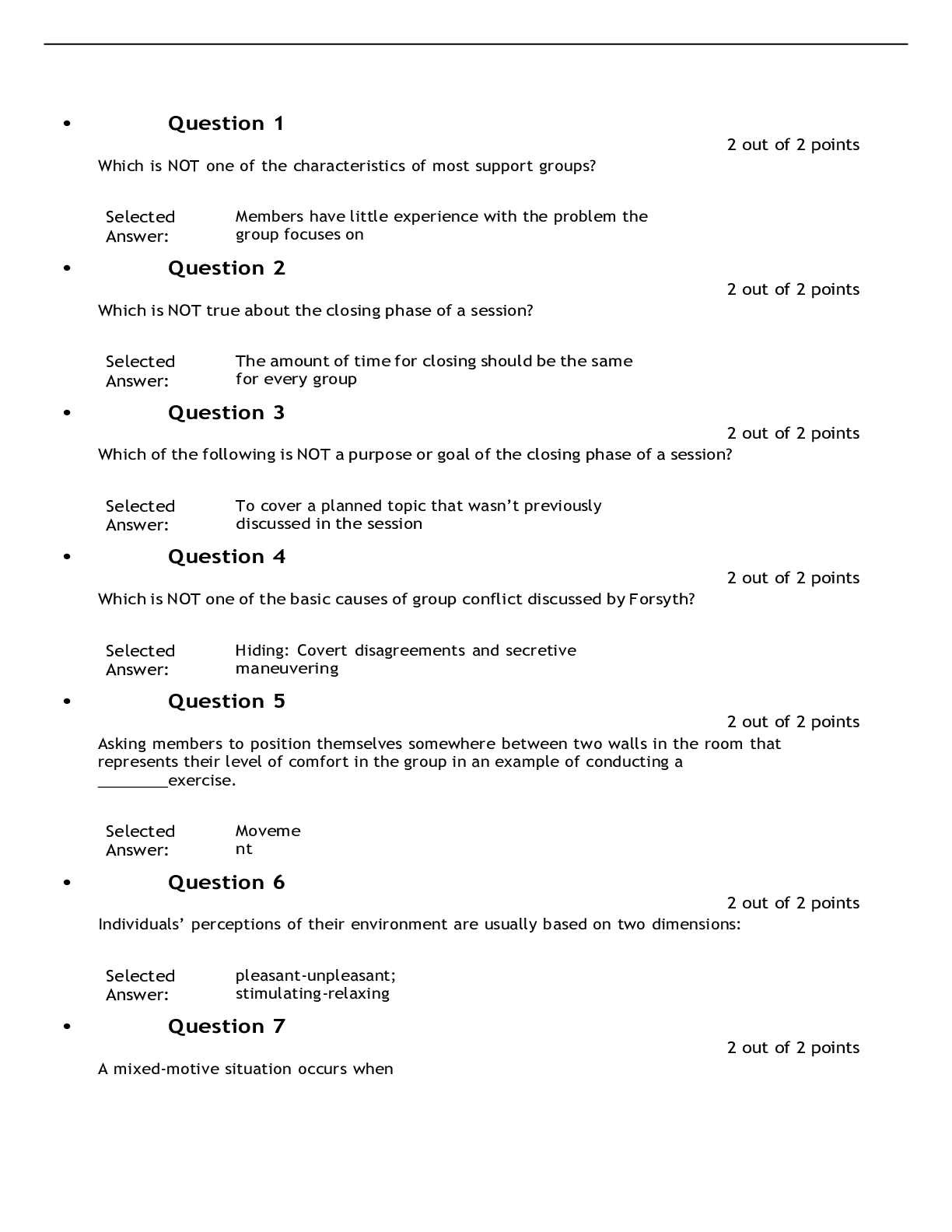

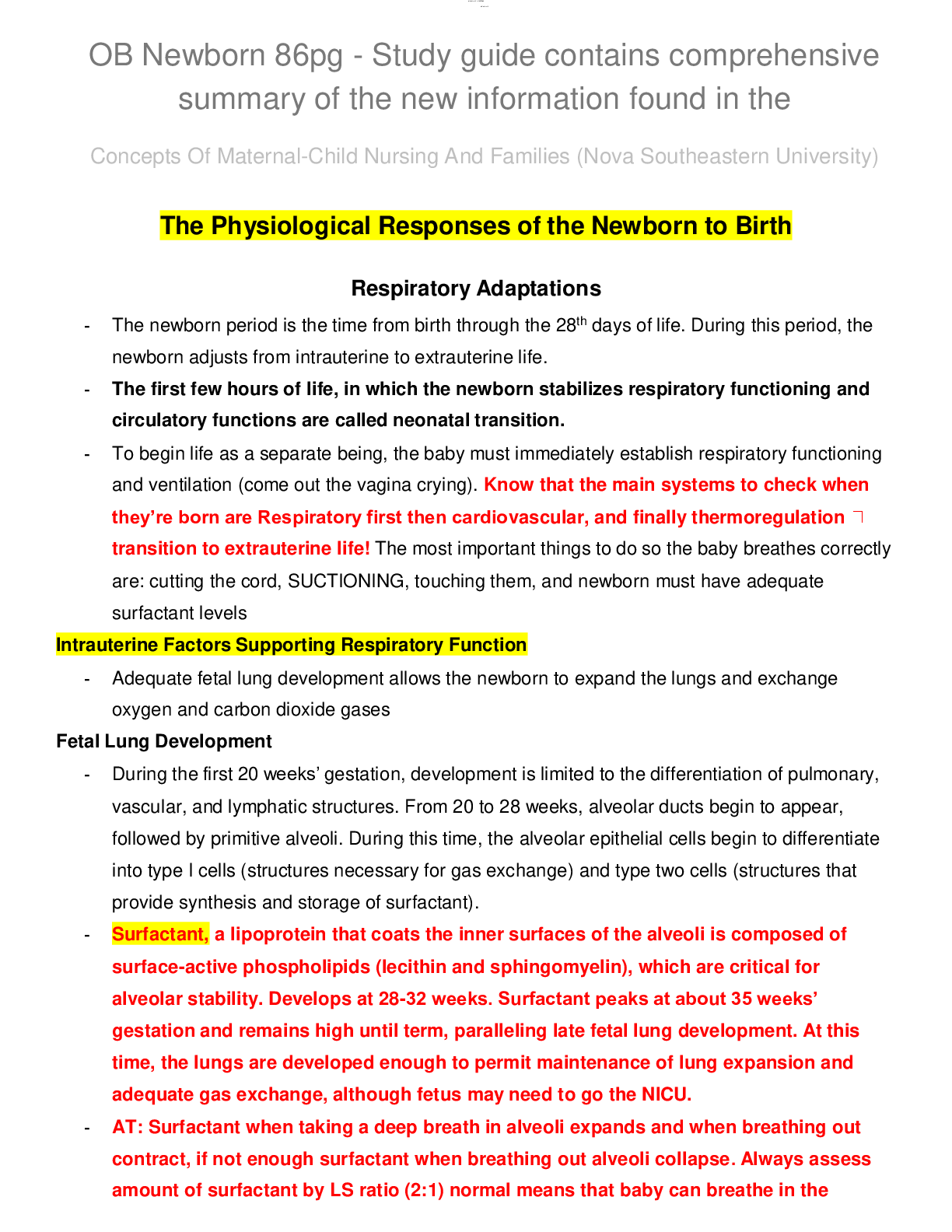
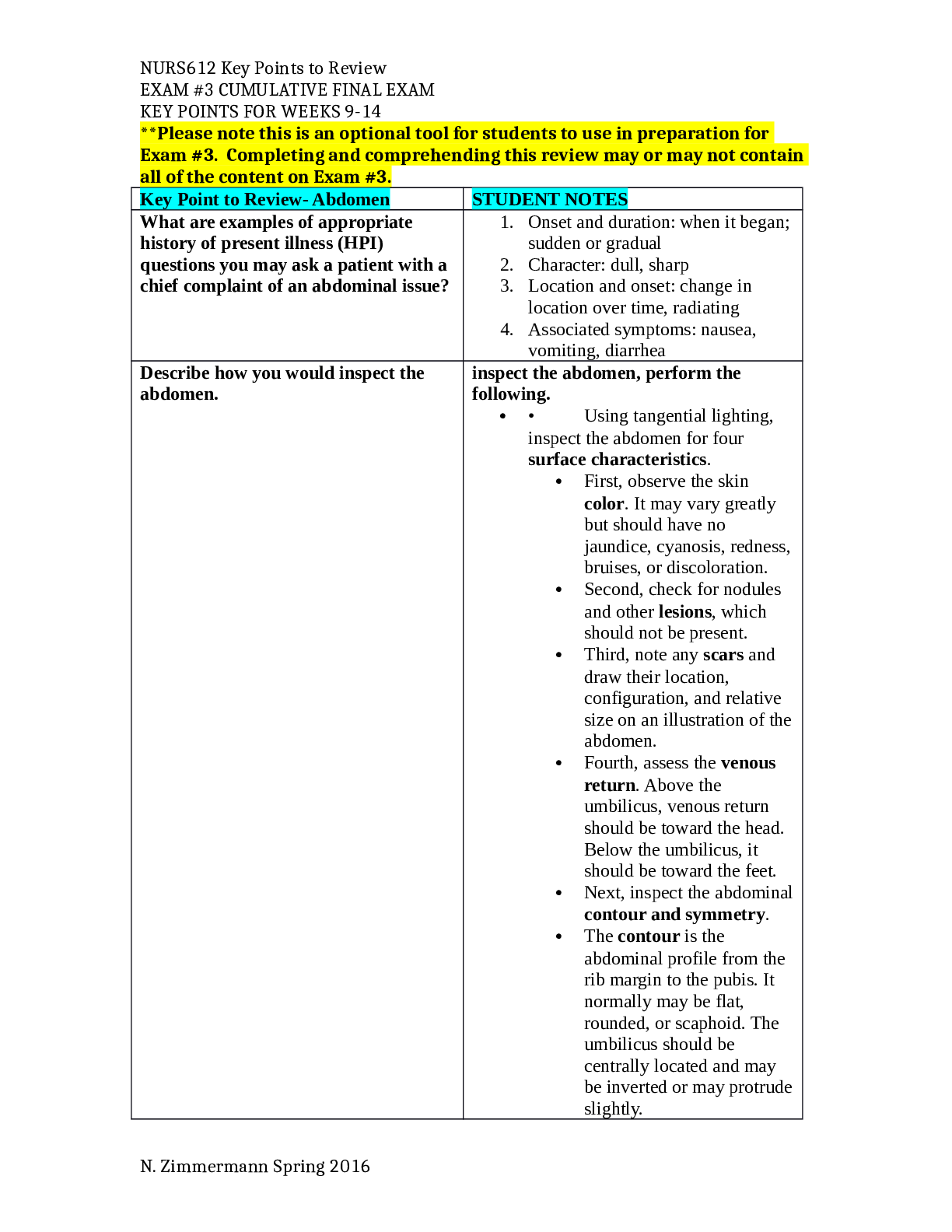


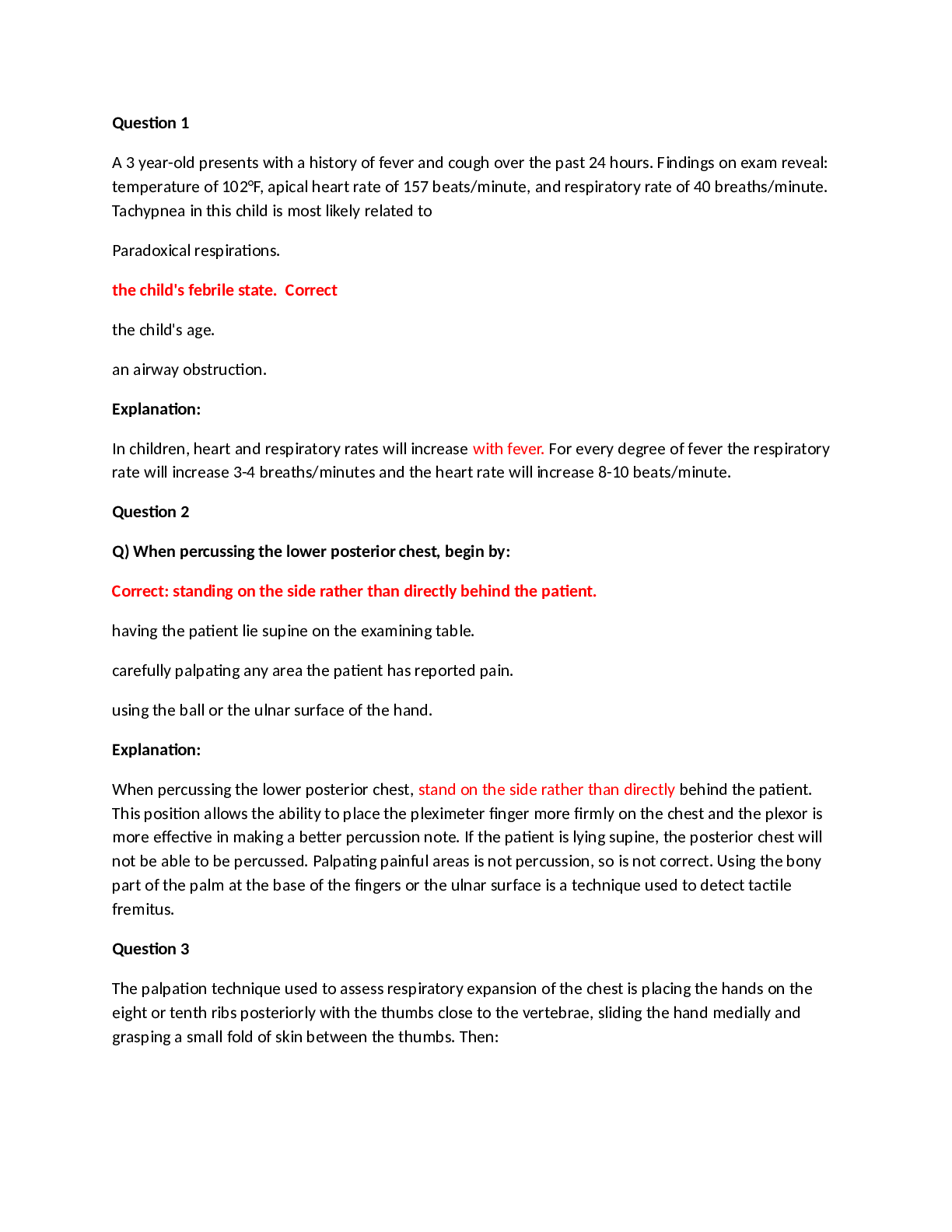
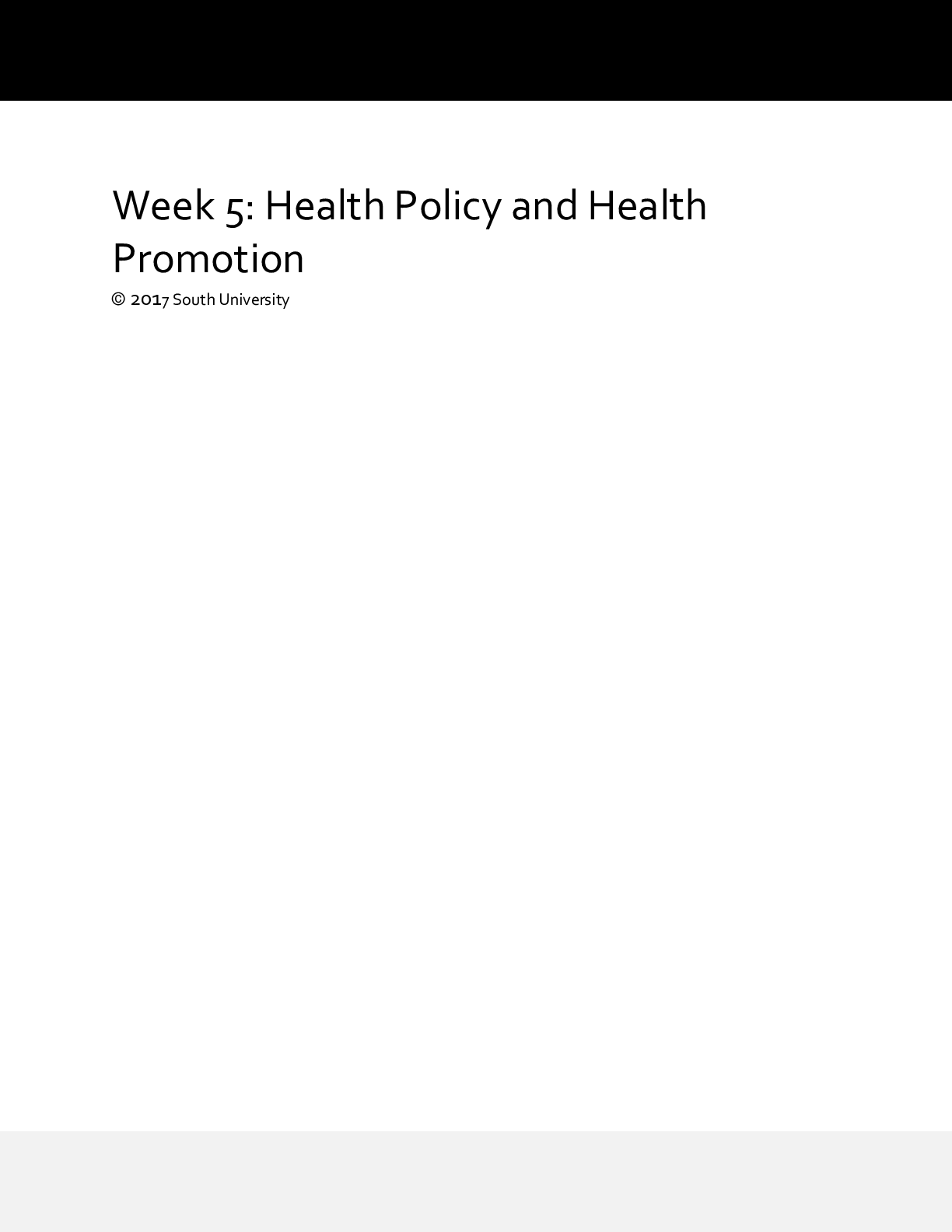
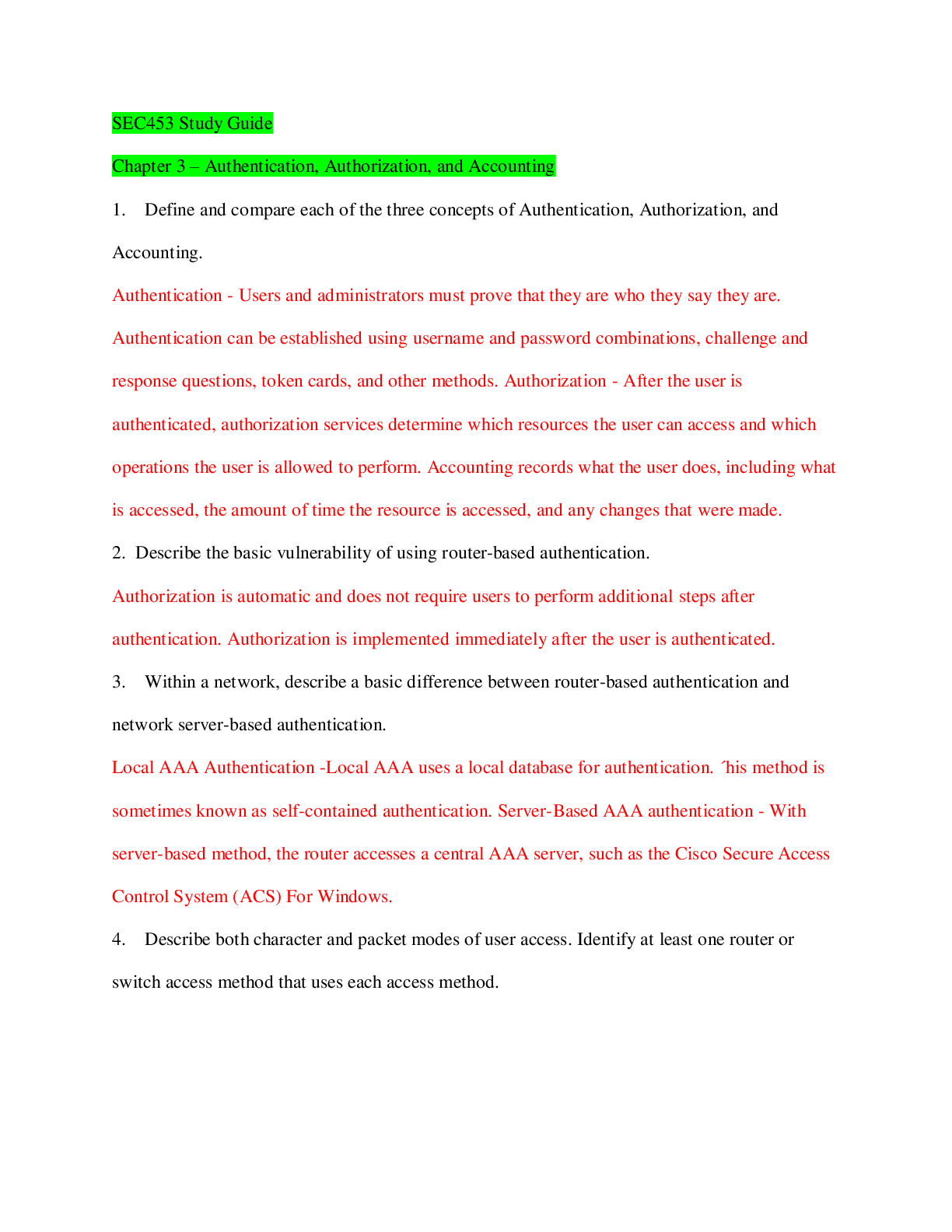
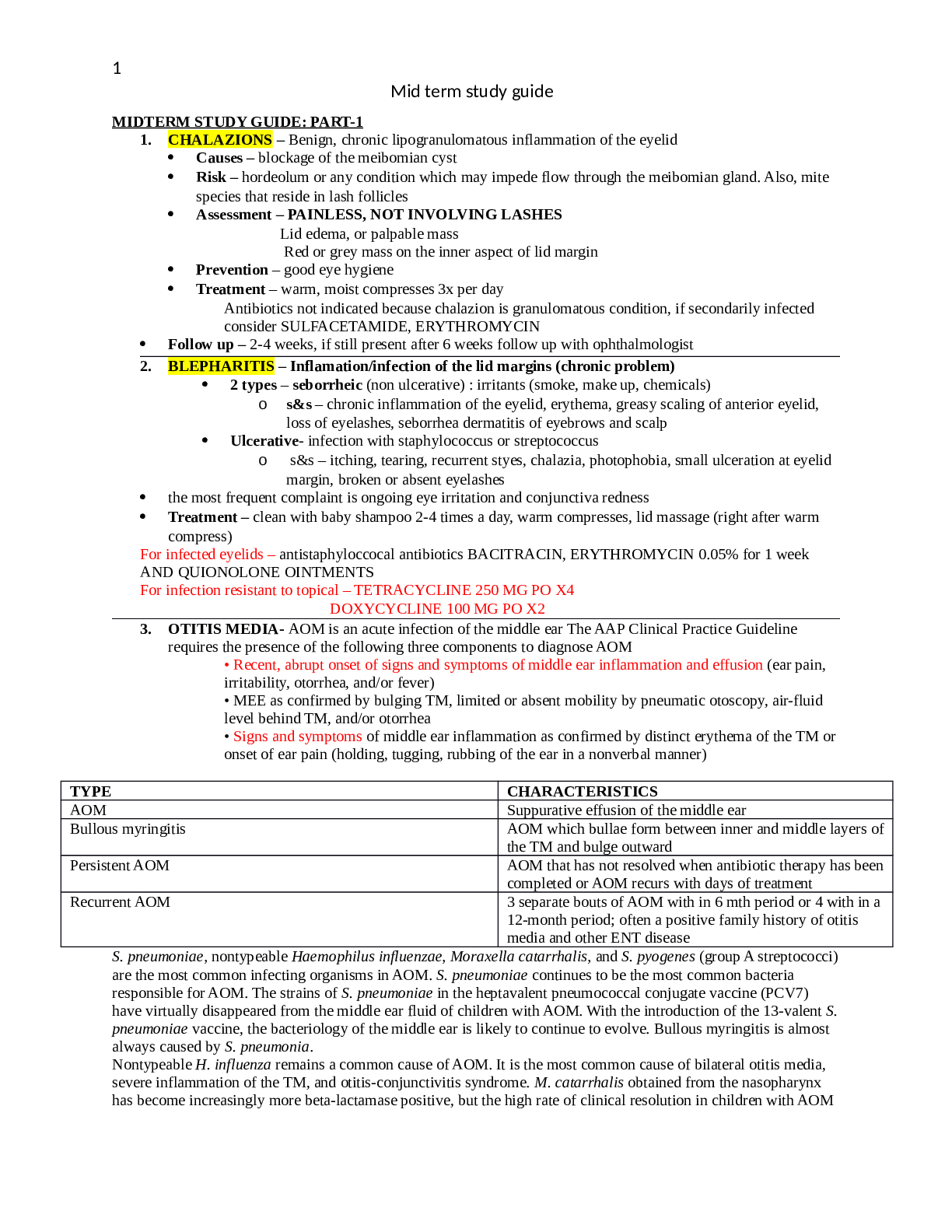

 (2).png)
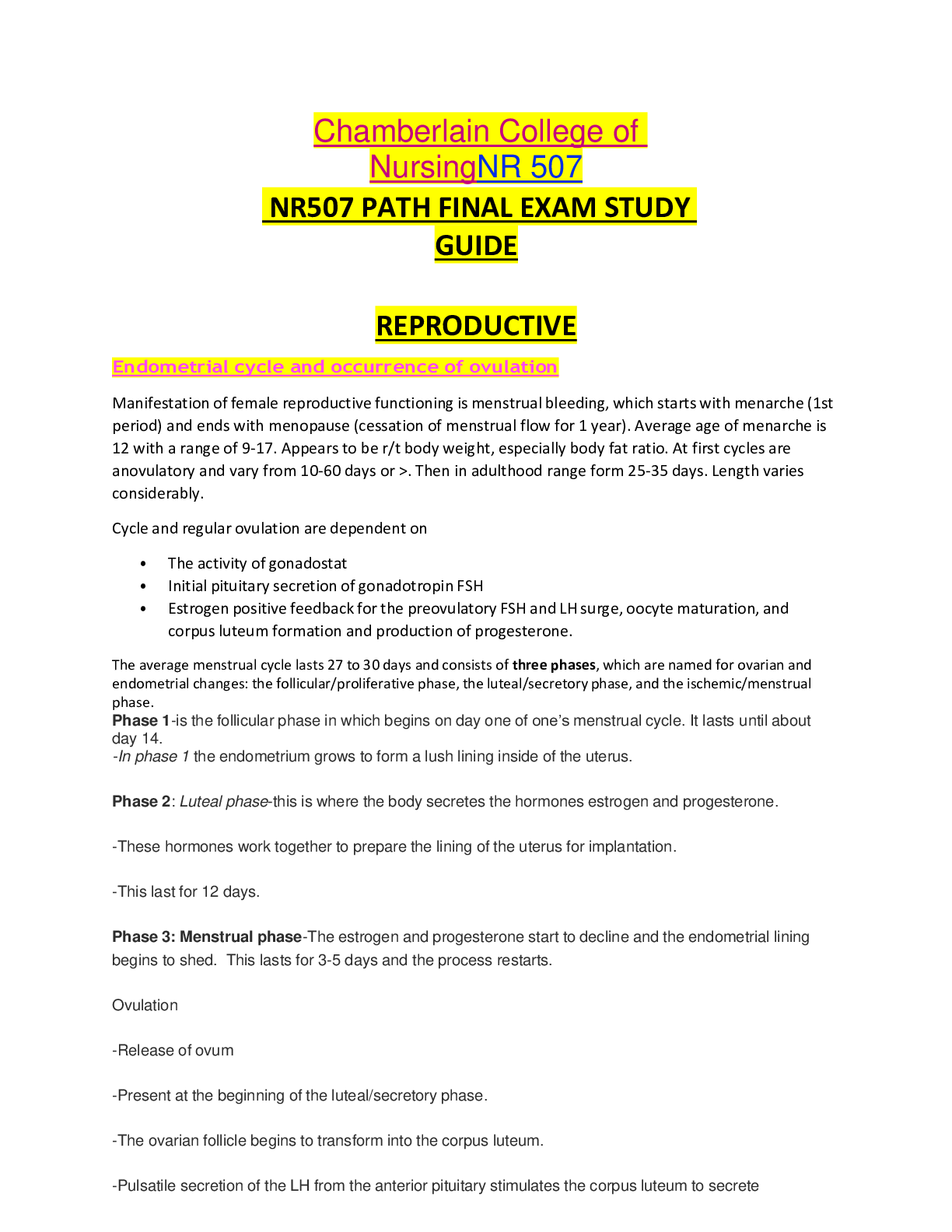
.png)
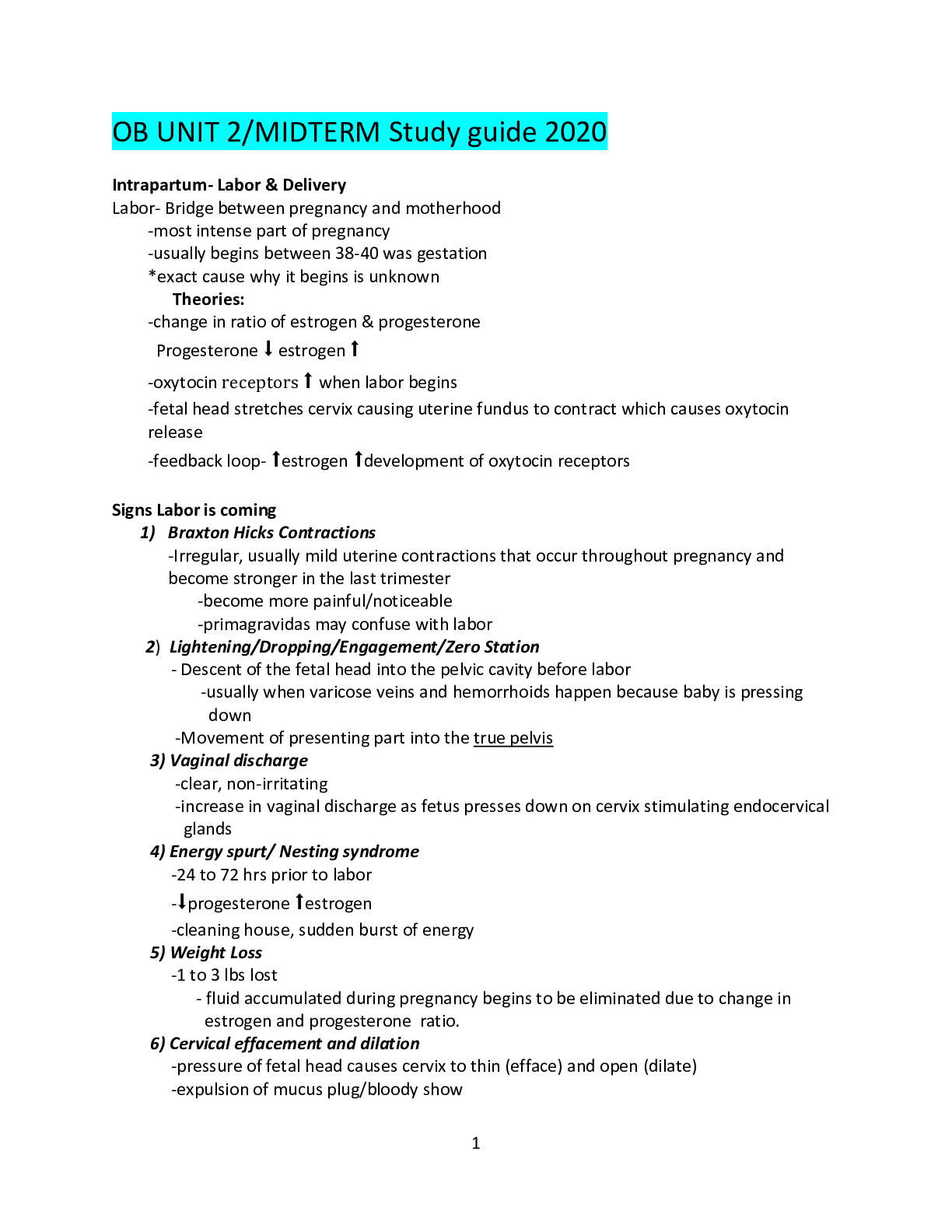
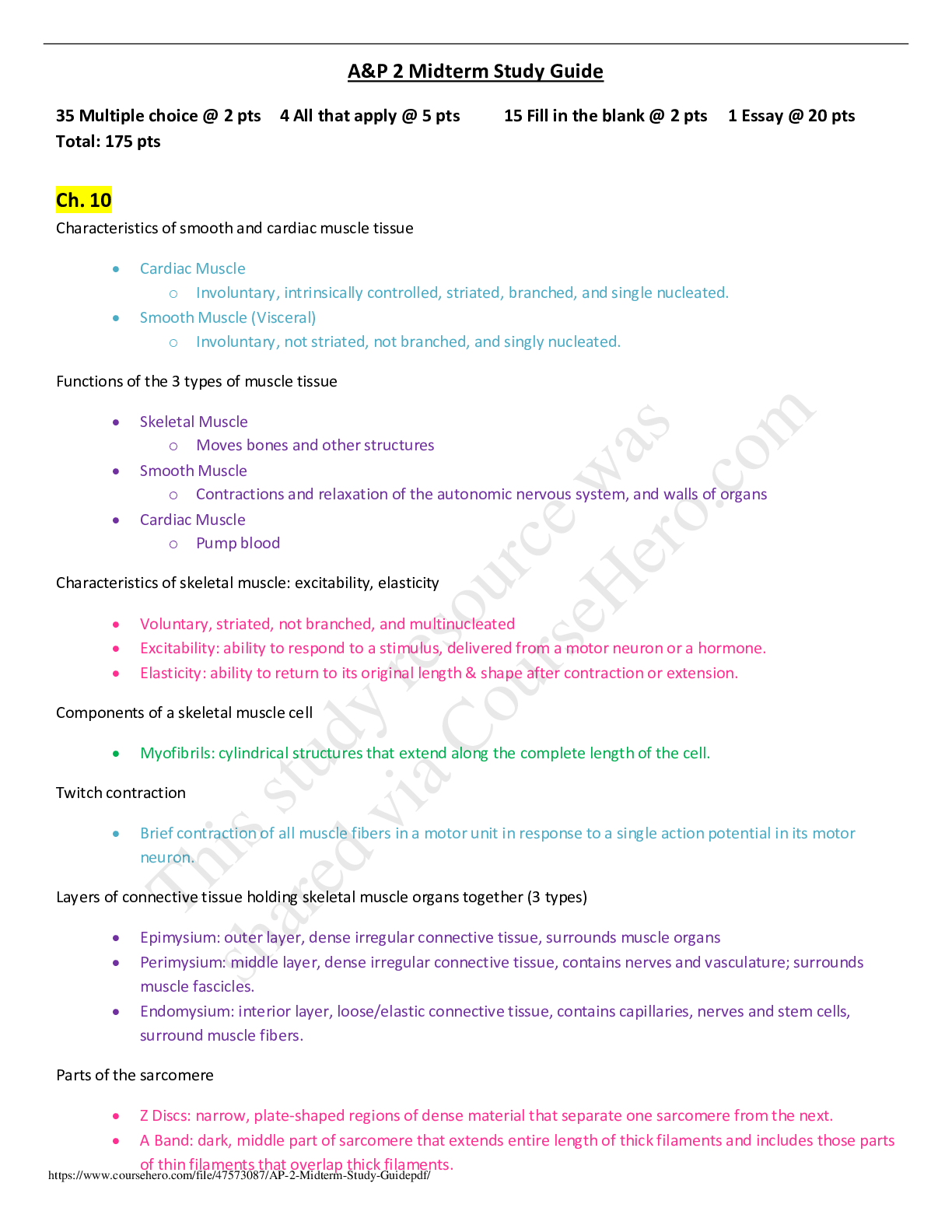

 5.png)
.png)

